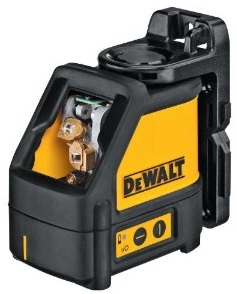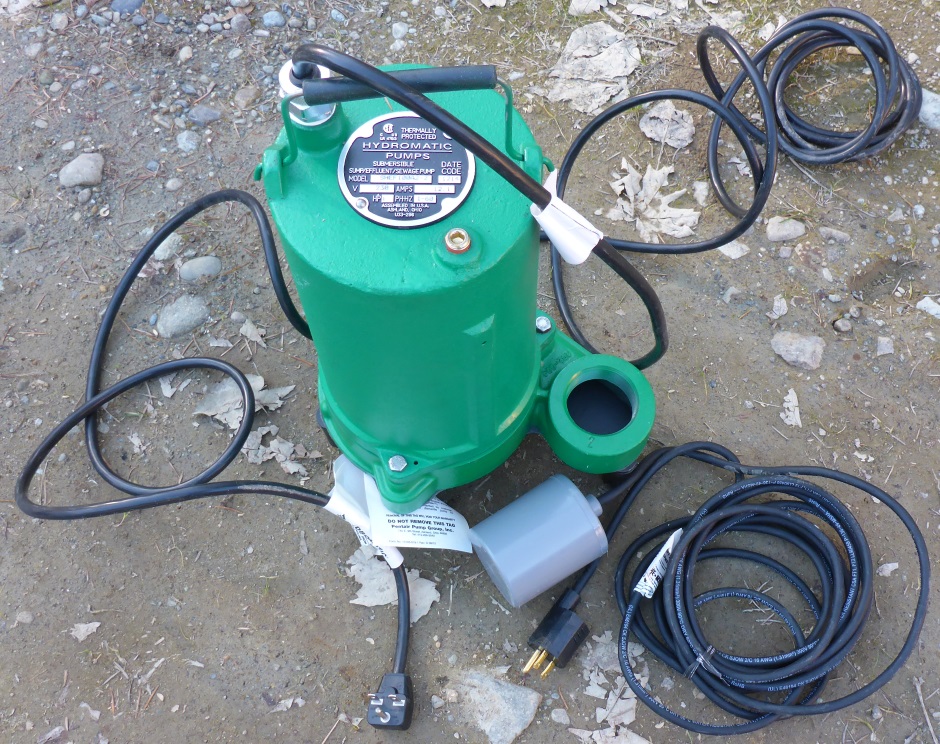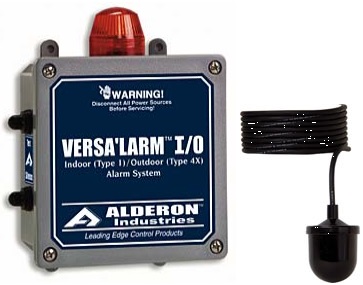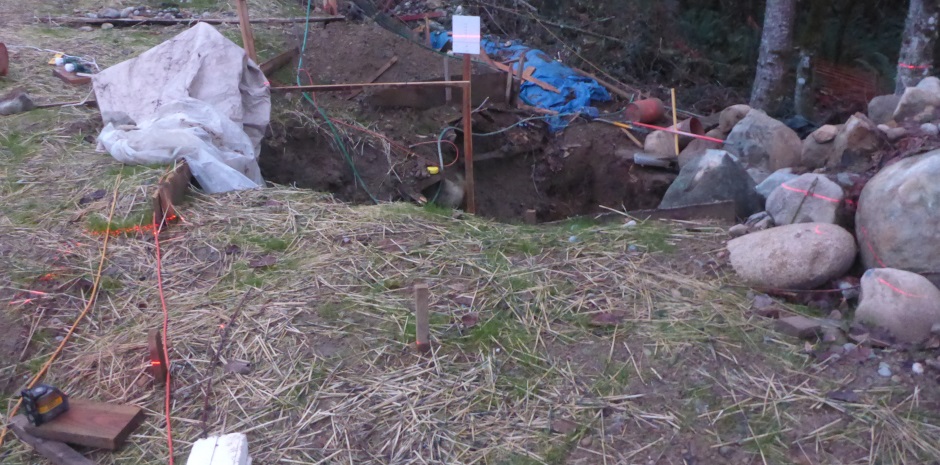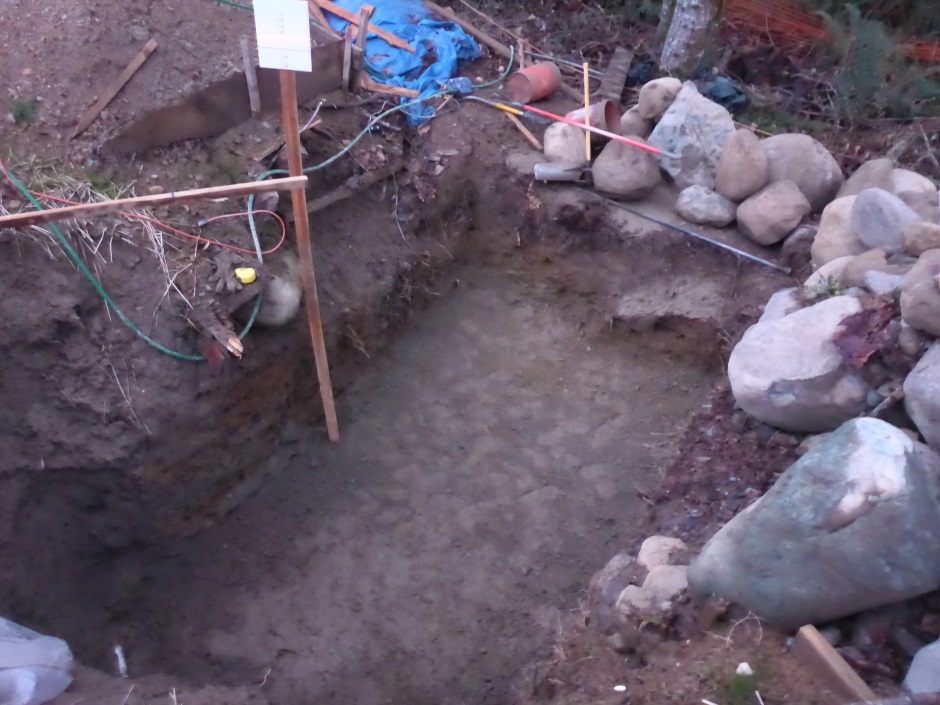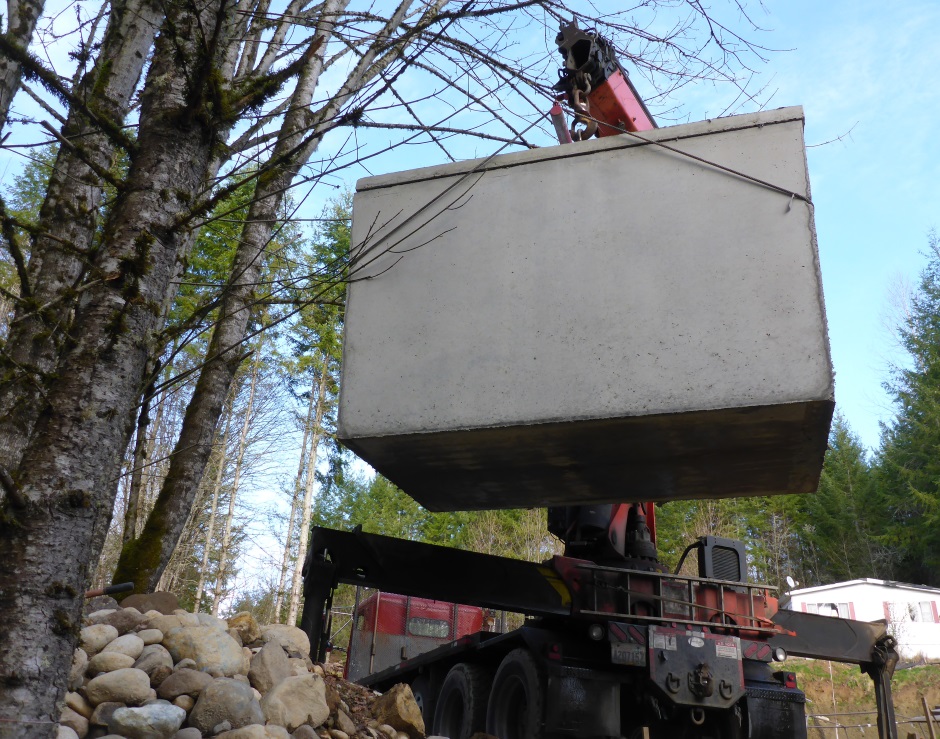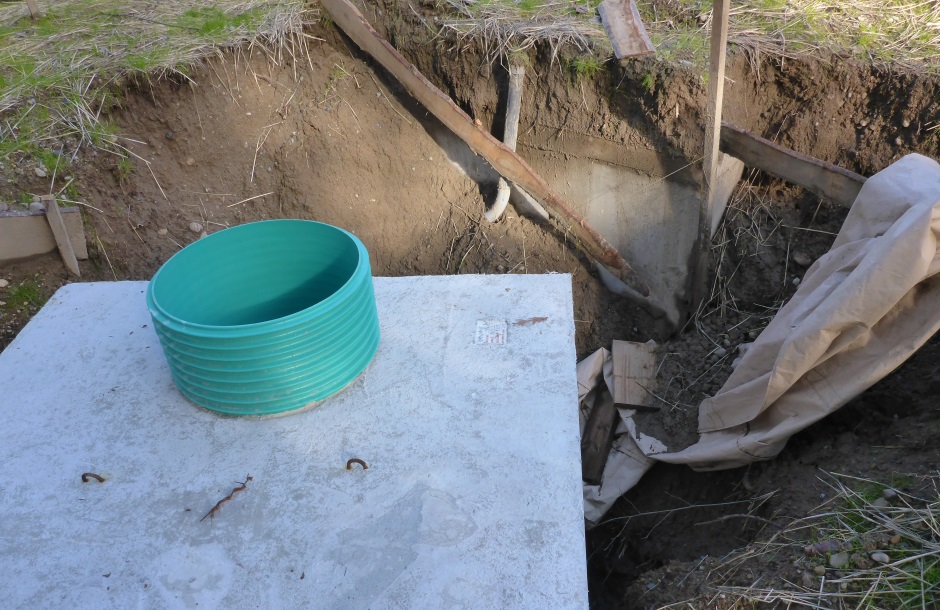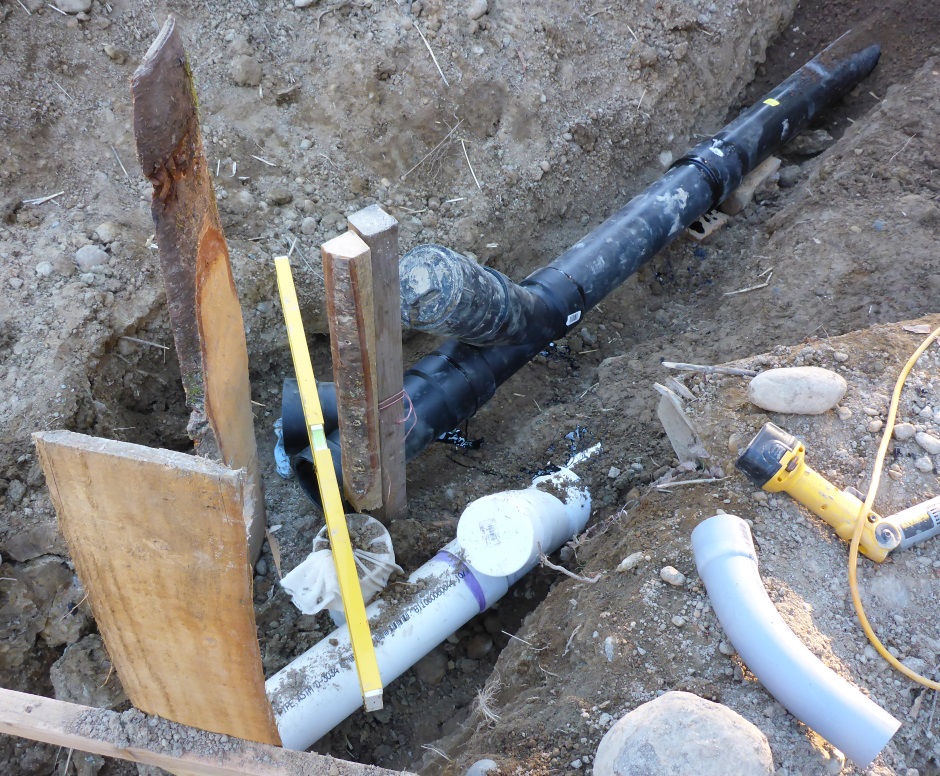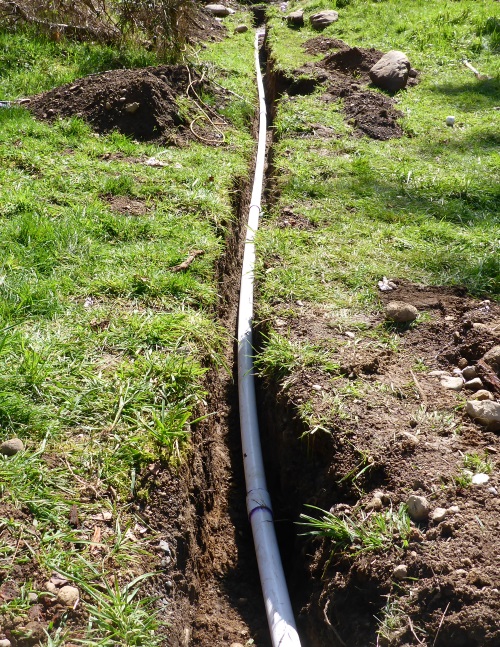Home Site Map - Techniques - Plot Infrastructure -
Sewage System
![]() How to implement a local health authority compliant sewage septic
system and even pump sh*t uphill.
How to implement a local health authority compliant sewage septic
system and even pump sh*t uphill.
The lay of the land
Sewage is typically routed from a house to a septic system using 4" pipe that is angled downhill at an angle of 1/4" per foot. In my case however, I am building the new house lower on the plot than the existing septic system. Given that sh*t never naturally flows uphill it is necessary to pump it from the house to the septic. In my case it needs to go up a rise of 22 feet. When calculating rise, don't forget to include the height of the pump tank (typically about 5 feet).
Theoretically all you need is a thing called a "Lift Station" that is a tank and a pump that gets it up to the 4" sloped pipe so it can gravity feed the last bit into the existing septic tank, but that may not be enough to satisfy your local health department. (My unsuccessful lift station design is here.) My local health department determined that because I was building an all new house and removing the old dwelling then I needed to start over with an all new septic tank and new pump tank. Rather than discharge into my existing septic tank they required me to decommission the existing tanks and pump directly to the sand filter. I am doing what they require.
Determining lift height
Putting a laser level at the point where you need to get to will allow you to measure down from the laser line (best done at dusk so you can see the laser line).
The height that counts is the distance down from the laser line to near the bottom of the tank. The tank inlet needs to be set at a level such that it allows for a 1/4" per foot downward slope from the house sewage stacks.
It is good to try to keep the lift height as small as possible so you can use a less expensive pump. Rather than have the sewer stack pipes come out through the house slab, it is better to have them combine inside the basement and come out through the basement wall. This means that the septic tank can be about 6 foot higher than if the sewer exit pipe had to route under the footings. Coming through the wall will require the use of wall mounted toilets in the basement (if you are having any basement toilets) and some raised floors in the basement, but that's ok. Having the sewer pipes come through the wall has the added advantage that the piercing through the house waterproof membrane is more accessible (just dig away the back fill) compared with having it under the slab. In my design, the 4" ABS pipe will come out with its center 8" above the slab. It is worth doing a CAD drawing to make sure you have worked out the heights right.

In my case the measured lift height is about 20 feet. Let's call it 22 feet to be safe.
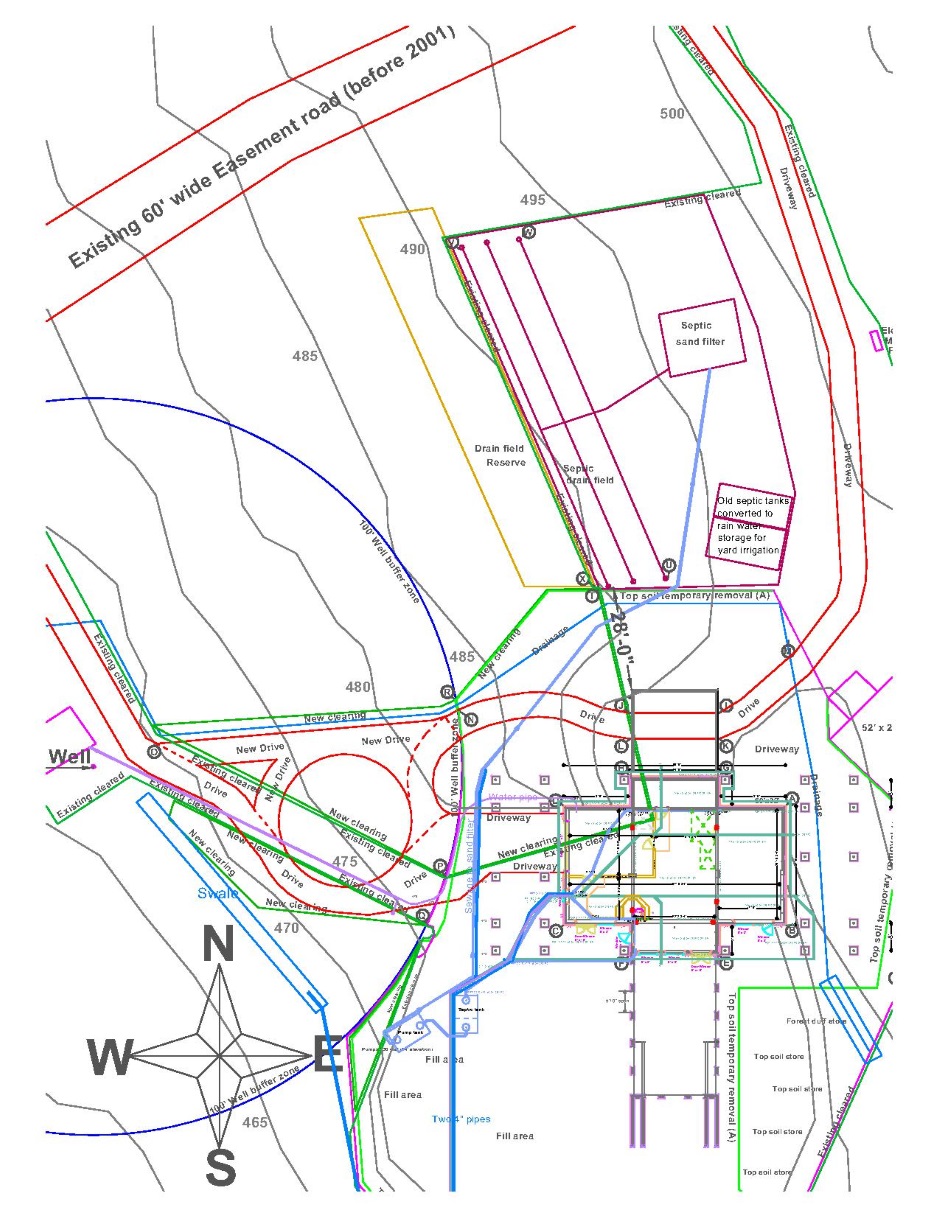
When deciding on how much lower the pump tank needs to sit relative to the septic tank it is important to allow for the fact that, depending on the particular tank design, the output hole from the septic tank may be slightly lower than the input hole on the pump tank.
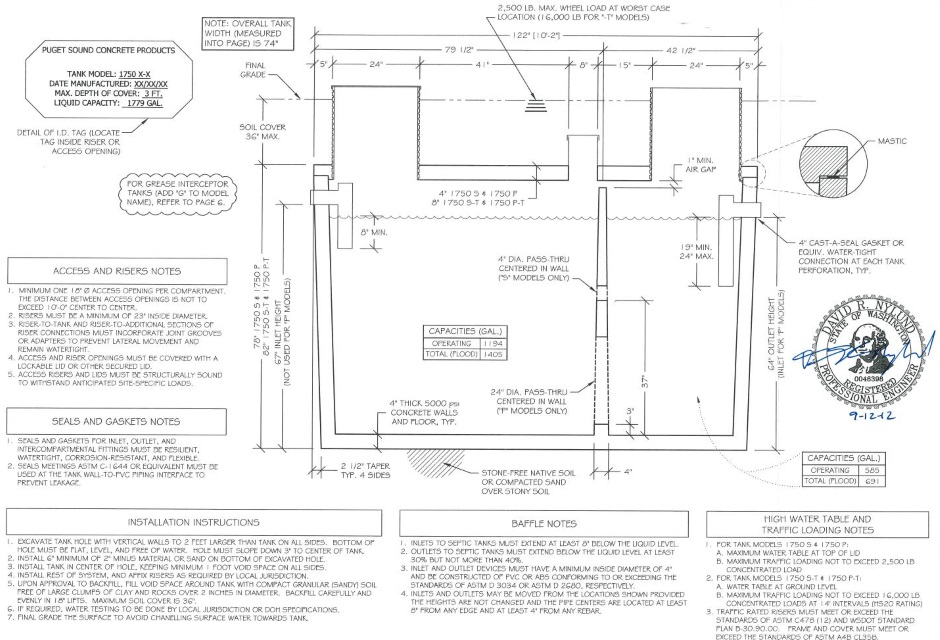
You want to have a slope of about 1/4" per foot on the pipe between the two tanks. For an 8' long pipe that means a 2" drop. Add to this the 3" difference in hole positioning and that means the pump tank needs to be at least 5" lower in the ground than the septic tank.
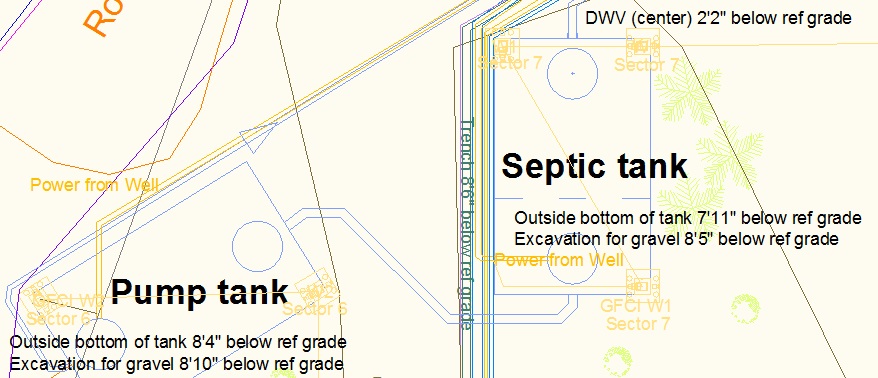
The routing of the DWV pipes to the fixtures in the basement all happens above the slab (and within the house envelope). You need to maintain the 1/4" per foot downward slope so the pipe gradually gets higher off the slab as you get further inside from the exit point. In the diagram below, the connection to the wall mounted toilet (if ever actually installed) is 24" above the slab. The toilet is designed for its exit to optimally be 10" above the floor so a raised floor that is 1'2" - 1'3" above the slab is needed to allow people to comfortably get on and off the toilet.
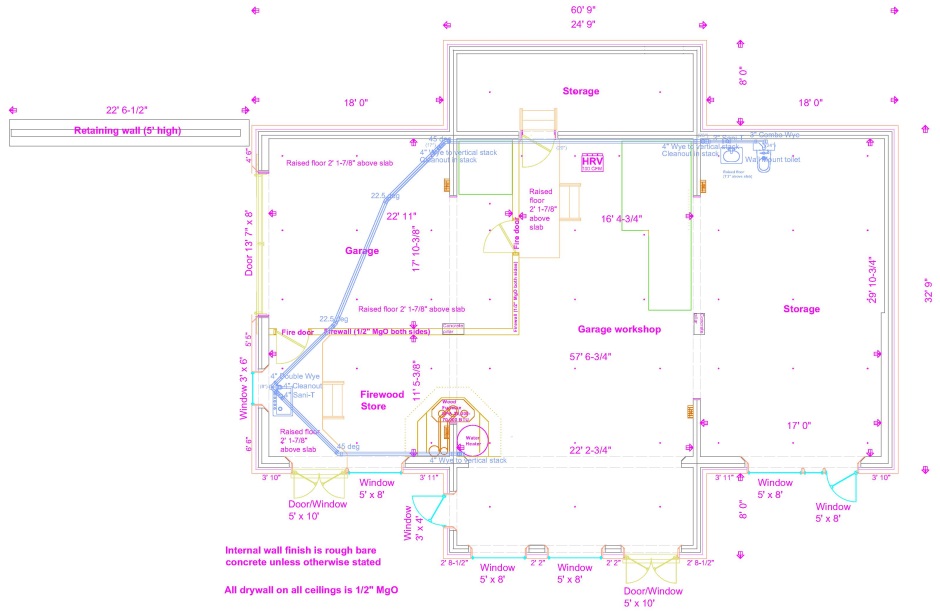
Types of septic system
Before going further it is worth looking at some general info on how septic systems are designed. Here is the simplest gravity feed type...
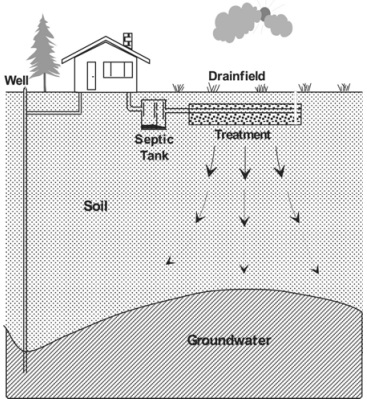
The system type you need depends on the depth of permeable soil found on your site. Tests will need to be performed to determine this. You may need the test done in multiple places on your plot to try to find a place with the greatest soil depth. If you can find a place with a good soil depth (greater than 4 feet) then the septic system will cost you a lot less than if you have a lesser soil depth.
Gravity drainfields
As the name implies gravity drainfields work by letting gravity drain the effluent from the septic tank into a series of trenches. This means that a gravity drainfield area must be below the draining level of the septic tank.
A gravity drainfield consists of a septic tank which flows effluent by gravity to a distribution box (D-box) (the second compartment of a dual chamber septic tank). One or more connections to this D-box drain into trenches typically filled with gravel. Only a small part of the drainfield is used at any one time. It requires a minimum of 48 inches of permeable soil above a restrictive layer to be used on new construction. It has the least amount of maintenance required of any system type, but requires the greatest soil depth in order to provide adequate treatment of the effluent. My soil was nothing like good enough to allow me to use a gravity system.
Gravity with Pump
If you have good soil (48 inches of permeable soil above a restrictive layer) but the drainfield is higher on the land than the septic tank then a pump tank is necessary and it is called a "gravity with pump" system.
The drainfield is dosed which permits intermittent resting of the drainfield between doses. Additional maintenance to the pump tank and float switches are necessary.
Pressure distribution drainfields
Pressure distribution systems are usually installed when there is less than optimal soil depth available for complete treatment of the effluent by a gravity system (or gravity with pump system). Pressure distribution systems always have a pump and therefore they dose the drainfield with effluent and then let it rest until the pump tank accumulates enough effluent from the household for another dose. In addition a series of pressurized lines from the pump tank to the drainfield, it makes sure the entire drainfield receives effluent at the same time.
It requires at least 30-36 inches of permeable soil above a restrictive layer to be used on new construction. Maintenance is required to assure the orifices do not plug over time.
Sand filter system
When there is minimal soil available for treatment, a sand filter system is sometimes used. This consists of a sand containment vessel between the pump tank and the pressurized drainfield. The sand acts to treat the effluent before it enters the shallow soils on site. This effectively makes up for the lack of soil depth.
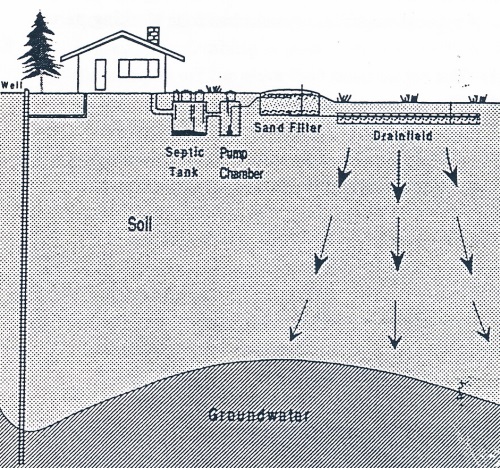
The sand filter typically has a pump tank inside it that gives pressurized doses to the drainfield.
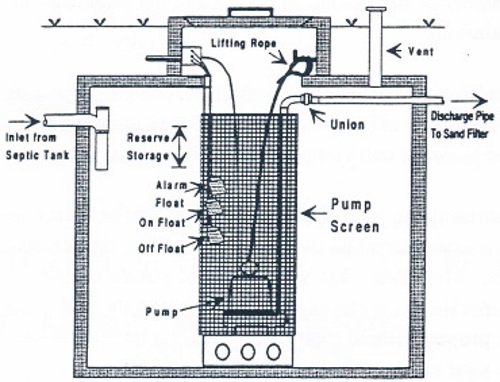
It consists of sand placed in a watertight box built into the soil. Effluent is spread evenly over the surface of the sand via a pressurized network. The sand layer treats the effluent and the effluent is collected in the bottom of the filter box from which it is then pumped to a drainfield. The drainfield is a pressure distribution system, which finishes the treatment process and then disposes of the wastewater. It requires at least 18 inches of permeable soil above a restrictive layer to be used on new construction. The complexity of this system and the situations in which it is used requires periodic maintenance and proper operation to assure continued performance standards be met over time. If you have 24" of permeable soil and a suitable slope then you might be able to use a gravity feed from the sand filter to the drainfield.
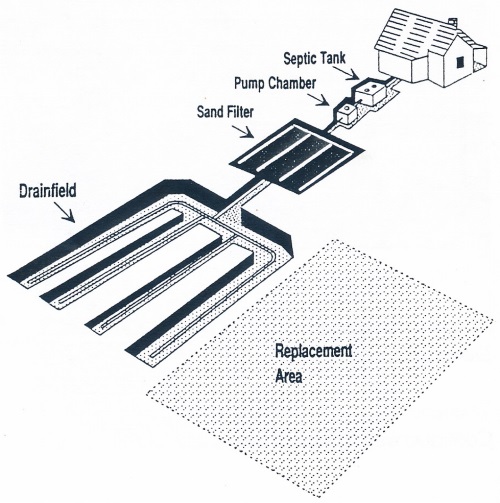
Mound system
Another system that can be used when a site has inadequate soil depth is a mound. A mound is a drainfield raised above the natural soil surface with a specific sand fill material. Within the sand fill is a gravel bed with a network of pressurized pipes. Septic tank effluent is pumped through the pipes in controlled doses to insure uniform distribution throughout the bed. Treatment of the effluent occurs as it moves through the sand and into the natural soil. Drainage around the mound site is critical if the system is to function properly. On sloping sites the downslope area below the mound must remain protected.
This diagram shows a sub-surface mound...
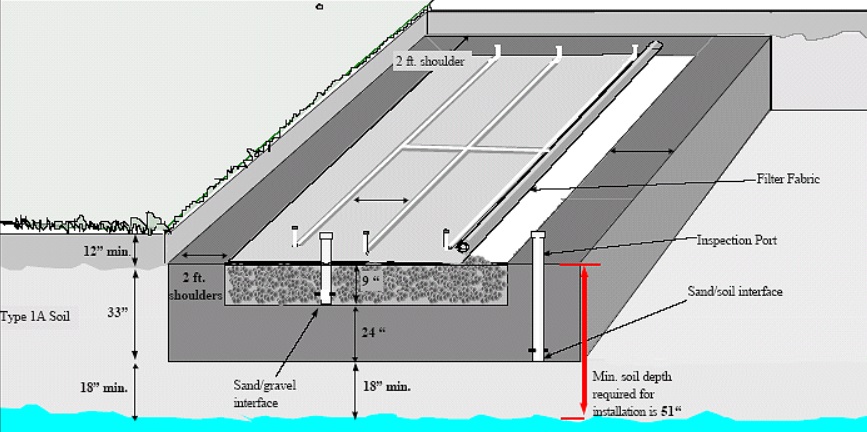
A treatment-based system consisting of pressurized lines lying in a sand bed mounded above the original soil surface. Requires at least 18 inches of permeable soil above a restrictive layer to be used on new construction. This system type has allowed construction on sites previously thought unsuitable due to lack of soil depth. The complexity of this system and the situations in which it is used requires periodic maintenance and proper operation to assure continued performance standards be met over time.
Sand filter + Mound
If you only have 12" of permeable soil then you may need to use both a Sand Filter and a Mound.
Septic system components
Septic tank
The typical septic tank is a large buried rectangular or cylindrical container made of concrete, fiberglass, or polyethylene. Wastewater from your toilet, bath, kitchen, laundry, etc. flows into the tank. Heavy solids settle to the bottom where bacterial action partially decomposes them to digested sludge and gases. Most of the lighter solids, such as fats and grease, rise to the top to form a scum layer.
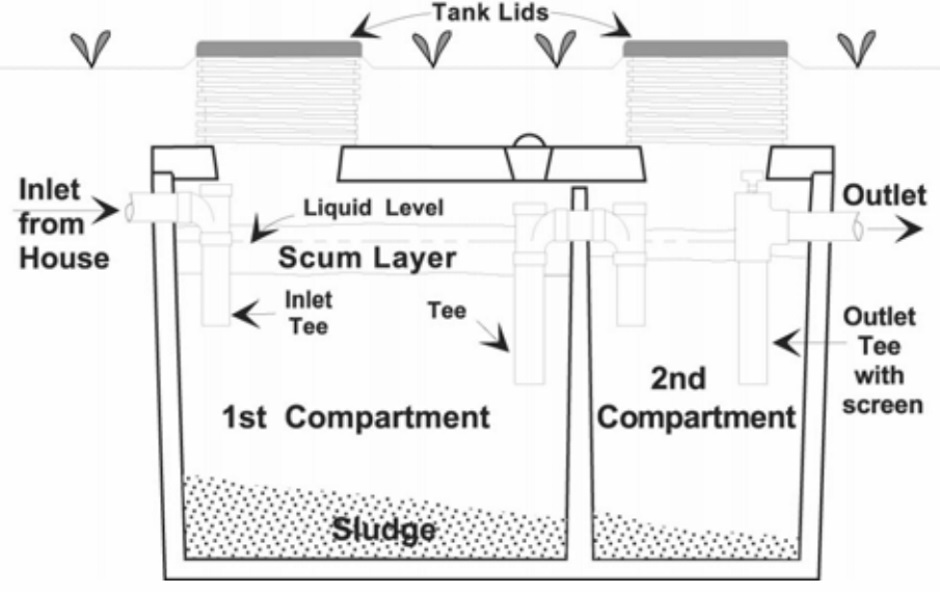
Septic tanks may have one or two compartments, but in my area the use of a dual compartment tank is mandatory. Two compartment tanks do a better job of settling solids and are required for new systems. Tees or baffles are provided at the tank's inlet and outlet pipes. The inlet tee slows the incoming waste and reduces the disturbance of the settled sludge. The outlet tee keeps the solids or scum in the tank. All tanks should have accessible covers for checking the condition of the baffles and for pumping both compartments. If risers extend from the tank to or above the ground surface, they should be secure to prevent someone accidentally falling into the tank. Solids that are not decomposed remain in the septic tank. If not removed by periodic pumping, solids will accumulate until they eventually overflow into the drainfield (which will wreck the drainfield). Most septic tanks need to be pumped every 3 to 5 years, depending on the tank size and the amount and type of solids entering the tank. Getting it pumped costs money so I prefer to use as large a septic tank as possible (1750 gallons).
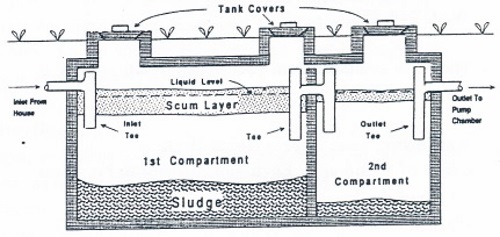
The septic tank should be pumped when:
1) The bottom of the scum layer is within 3 inches of the bottom of the outlet tee or baffle, or
2) The top of the sludge layer is within 12 inches of the bottom of the outlet fitting.
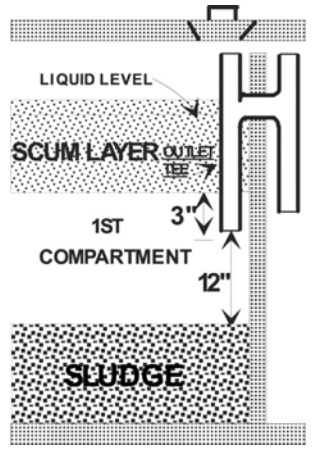
The wastewater leaving the septic tank is a liquid called effluent. It has been partially treated but still contains disease-causing bacteria and other pollutants. Discharging effluent onto the ground's surface or into surface and ground water is against the law in most jurisdictions.
Sand Filter
The sand filter itself is a concrete or PVC-lined box filled with a specific sand material. A network of pressurized lines is placed in a gravel-filled bed on top of the sand. The septic tank effluent is pumped through the pipes in controlled doses to insure uniform distribution. As the effluent trickles down through the sand it is treated. A gravel underdrain collects and moves the treated wastewater to either a second pump chamber for discharge into a pressurized drainfield or (less likely) the filter can sometimes drain into a gravity flow drainfield. The second pump chamber is commonly located within the sand filter.
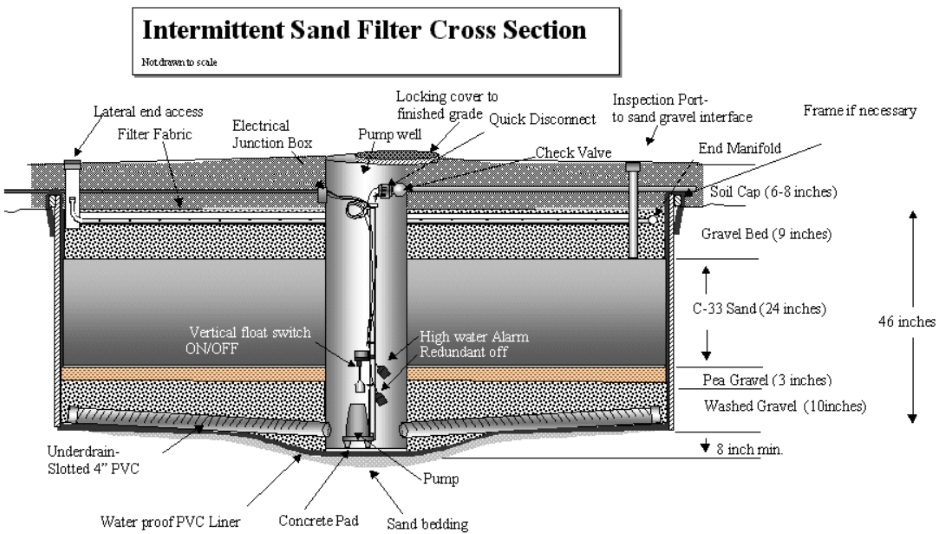
Drainfield
A drainfield consists of a network of 4 inch diameter perforated pipes laid in gravel-filled trenches (2-3 feet wide) in natural undisturbed soil. The bottom of the trench needs to be 3 feet above any restrictive layer, such as a hardpan, or water table. The soil between the bottom of the trench and the hardpan or water table is used in the final treatment of the septic tank effluent. The soil below the drainlines filters effluent as it passes through the pore spaces. Chemical and biological processes treat the effluent as it percolates down through the soil. The treatment process cleans the effluent before it reaches the groundwater. This works best when the soil is somewhat dry, permeable, contains adequate amounts of oxygen, and there is enough soil depth to complete the cleaning process. The size of the drainfield depends on the estimated daily wastewater flow and soil conditions. The number of bedrooms and soil type determines the total number of square feet of drainfield area that is needed.
General info on septic systems
Much of the above info comes from the excellent info published by the King County Health Dept at http://www.doh.wa.gov/Portals/1/Documents/Pubs/337-086.pdf
Lots of good information also at http://www.kingcounty.gov/healthservices/health/ehs/wastewater/owners/types.aspx
http://www.kingcounty.gov/healthservices/health/ehs/wastewater/owners/works.aspx
Also see http://www.doh.wa.gov/CommunityandEnvironment/WastewaterManagement/FormsPublications#Tanks
http://www.doh.wa.gov/Portals/1/Documents/Pubs/337-083.pdf
http://www.doh.wa.gov/Portals/1/Documents/Pubs/337-003.pdf
The permit process
There is a rule here in King County that says that only a licensed septic designer is allowed to design a septic system. I did not know about that rule until after I had figured out a design, so I had to send my design to a licensed designer who was able to review my design notes and make it into an official design. It actually took two passes at this because the initial design was just for handling the first phase of construction rather than the full house that turned out to needed the complete new tank set. The following email from the inspector to the licensed designer explains the change in plan...
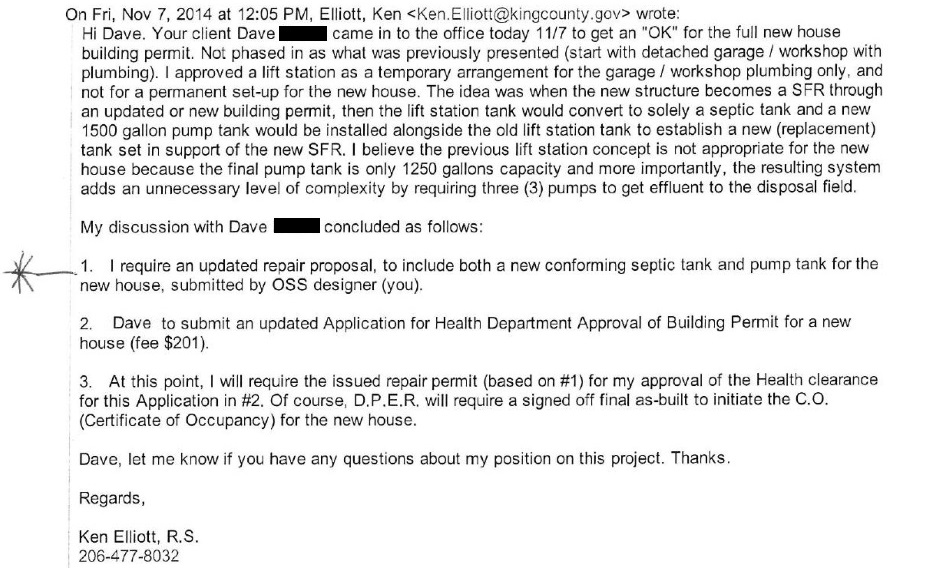
The septic design guy in Washington State that I used is...
Dave Huard
HSDM (Huard Septic Design & Monitoring)
425 831 1781
209 Main Ave S #112, North Bend, WA 98045
april@septicdesign.net
You need to take the design after it has been stamped by the licensed septic designer and submit it to the health department along with a set of filled in forms. You need to pay a fee (something like $500) to have them review the proposal. The health department will likely also want to see yearly inspection records for the existing septic system if there is one. For the annual inspections I used...
Jerry Murphy
Active Septic Solutions
32121 NE 8th St (at N Fall
City-carnation Rd)
Carnation, WA 98014
(425) 488-8689
If the health department accepts the plan then you pay an additional fee (something like $700) for a permit to do the implementation. Only once you have the full permit from the health department can you start work.
A further catch is that you are not actually allowed to do the work yourself. The health department will only issue the permit to a licensed septic installer (ie someone on the King County list). Furthermore even if the Licensed Septic *Designer* is also on the approved list of Licensed Septic *Installers* he cannot carry out the work because the same guy is not allowed to be both the designer and the installer for the project. I chose the following company for doing the installation work (with me in practice doing much of the work under their supervision)...
Dan Crocker Construction Inc
Mt Si Rd, Northbend, WA.
Steve
Neubauer
Cell-425-471-3375
Office-425-888-4136
steve@dancrocker.com
In a further catch, you actually need the Licensed Designer to submit a request to the Health Dept to get the Health Dept to release the permit to the Licensed Installer. You will have to pay the Licensed Designer for this service. A site visit from the Licensed Designer is required before he will officially request the permit. The Licensed Designer also has to inspect the work done by the Licensed Installer and sign-off on it in the form of an "As-Built" that gets submitted to the Health Department. You need an "As-Built" before you can get a Certificate of Occupancy on you house (which is required before you move in).
New Tank Set Design
The following docs, together with a map to show the inspector how to get to the site, made up my re-submission to the local health department for the all new tank set design. Also the proposed design is required to be sent direct from the Licensed Septic Designer to the King County Health Department. The docs below are shown in their signed approved form.
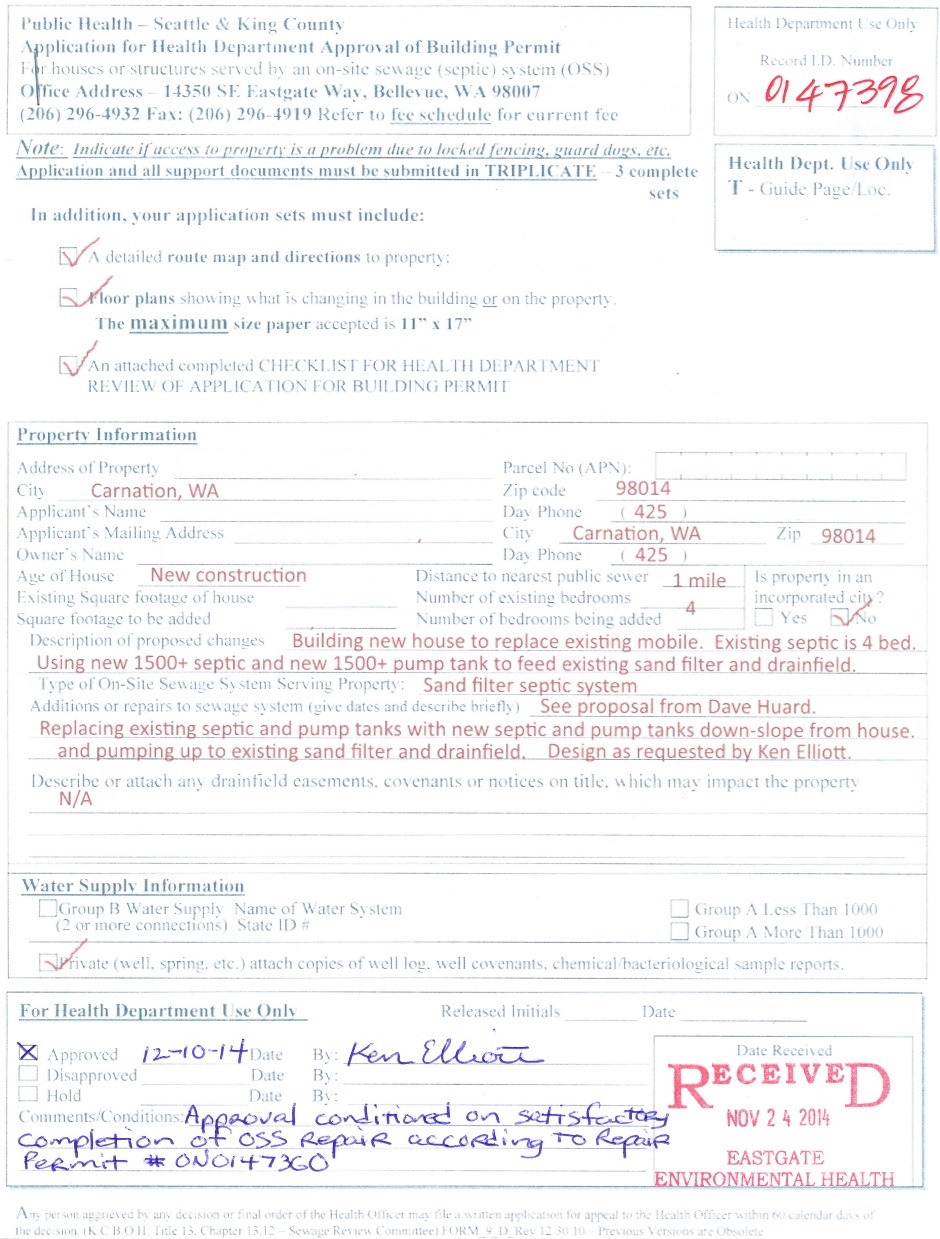
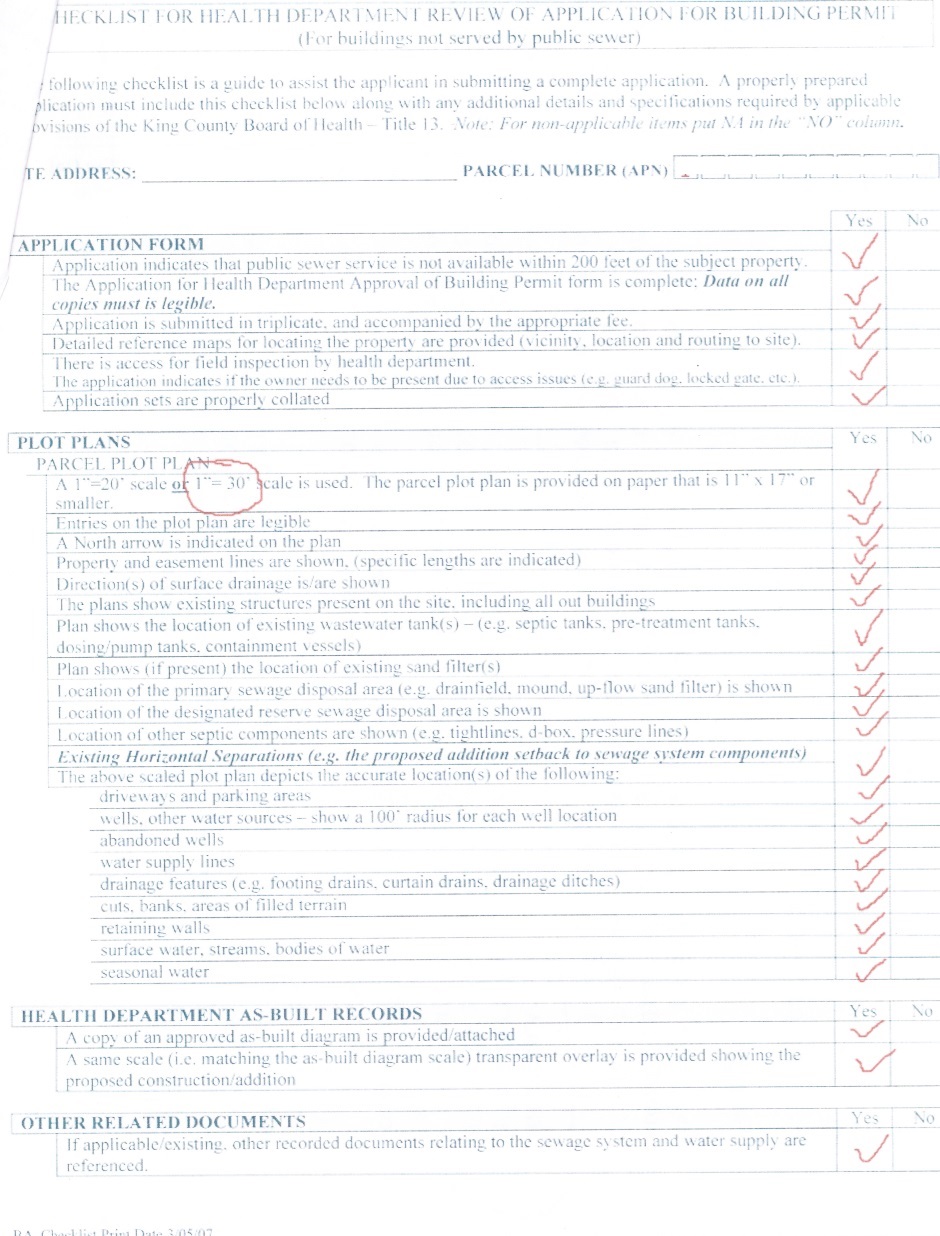
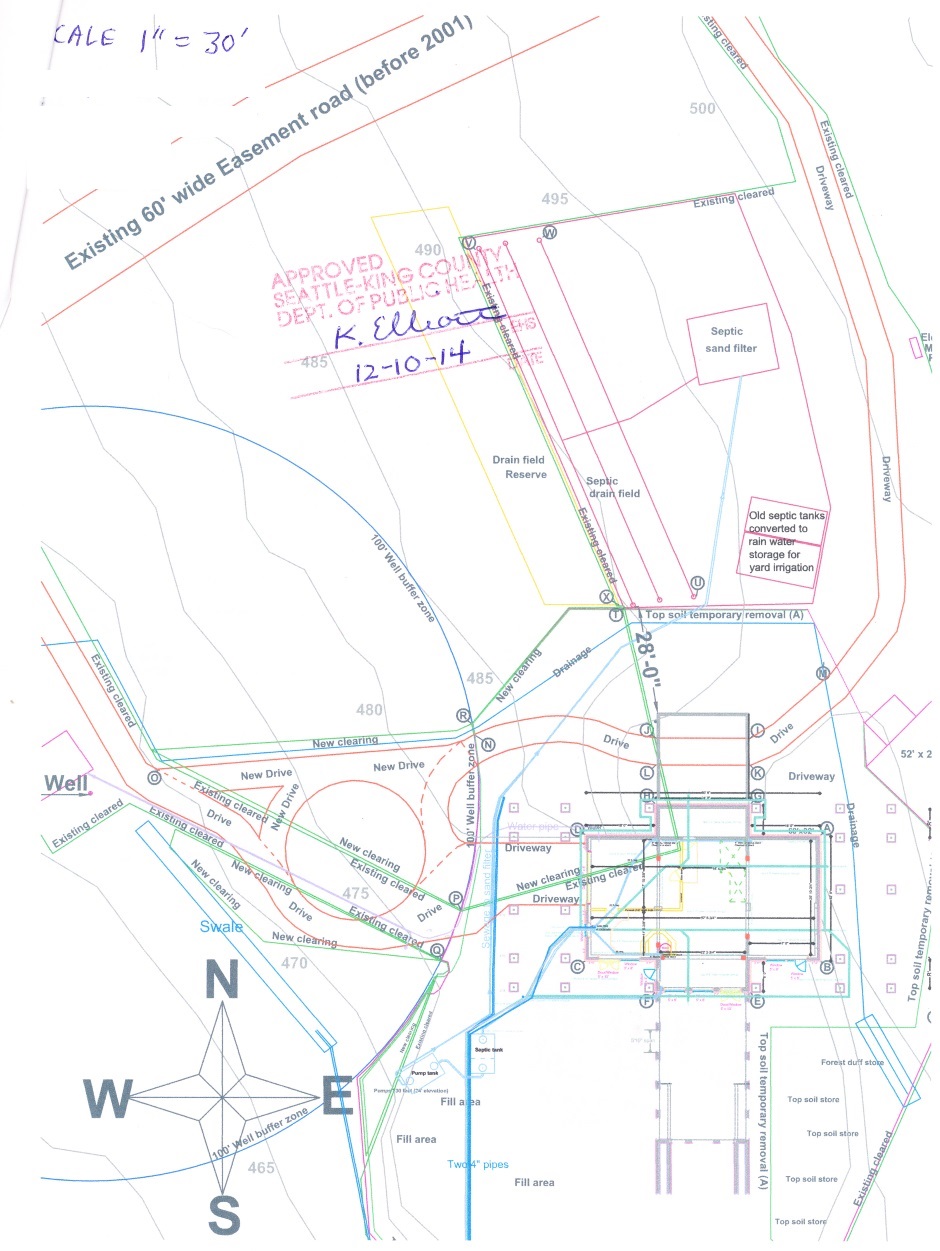
Note that the above sheet is important because it is a signed sheet that includes the words "Old septic tanks converted to rain water storage for yard irrigation". Without this signed note the Licensed Septic Installer company would be required to smash the existing concrete tanks and fill the remains with soil.
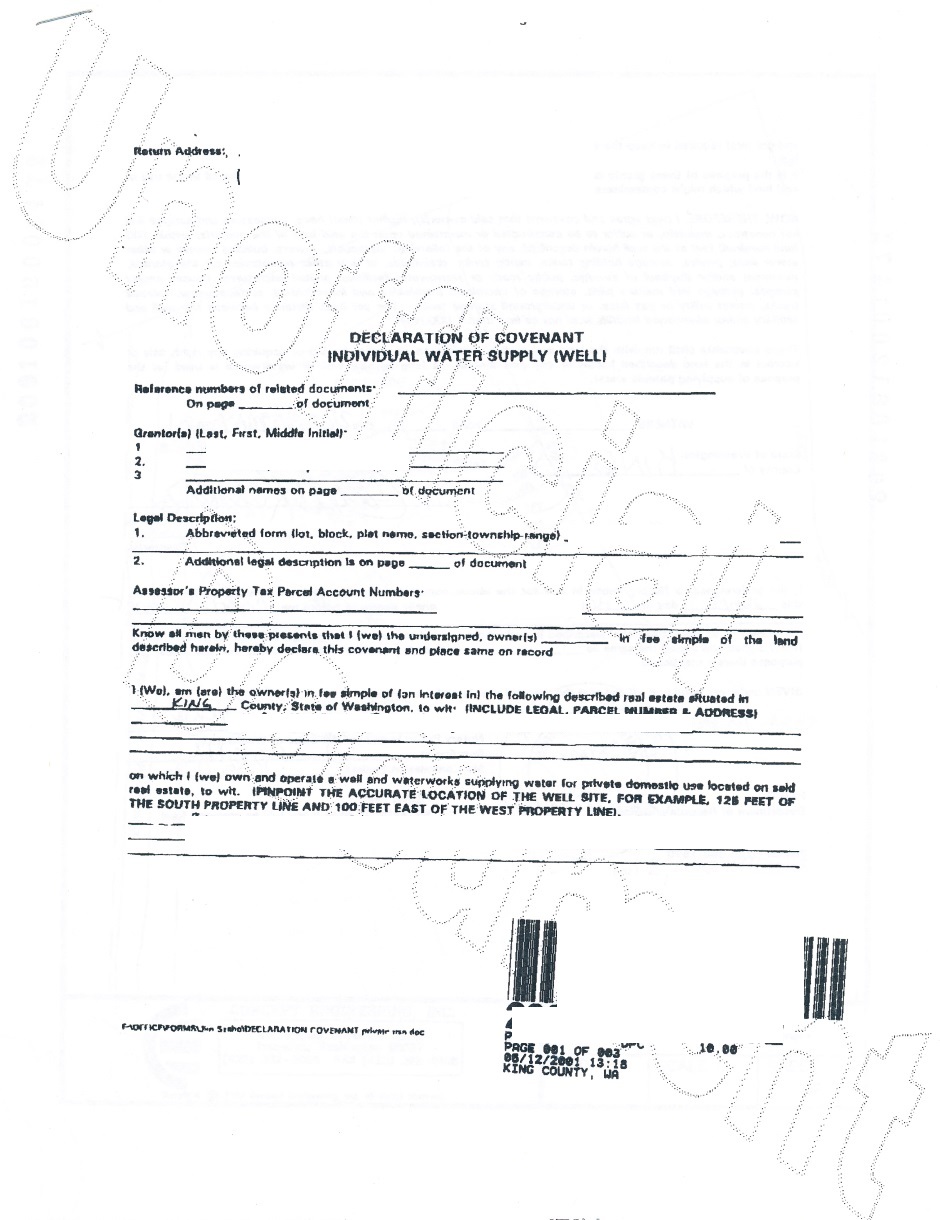
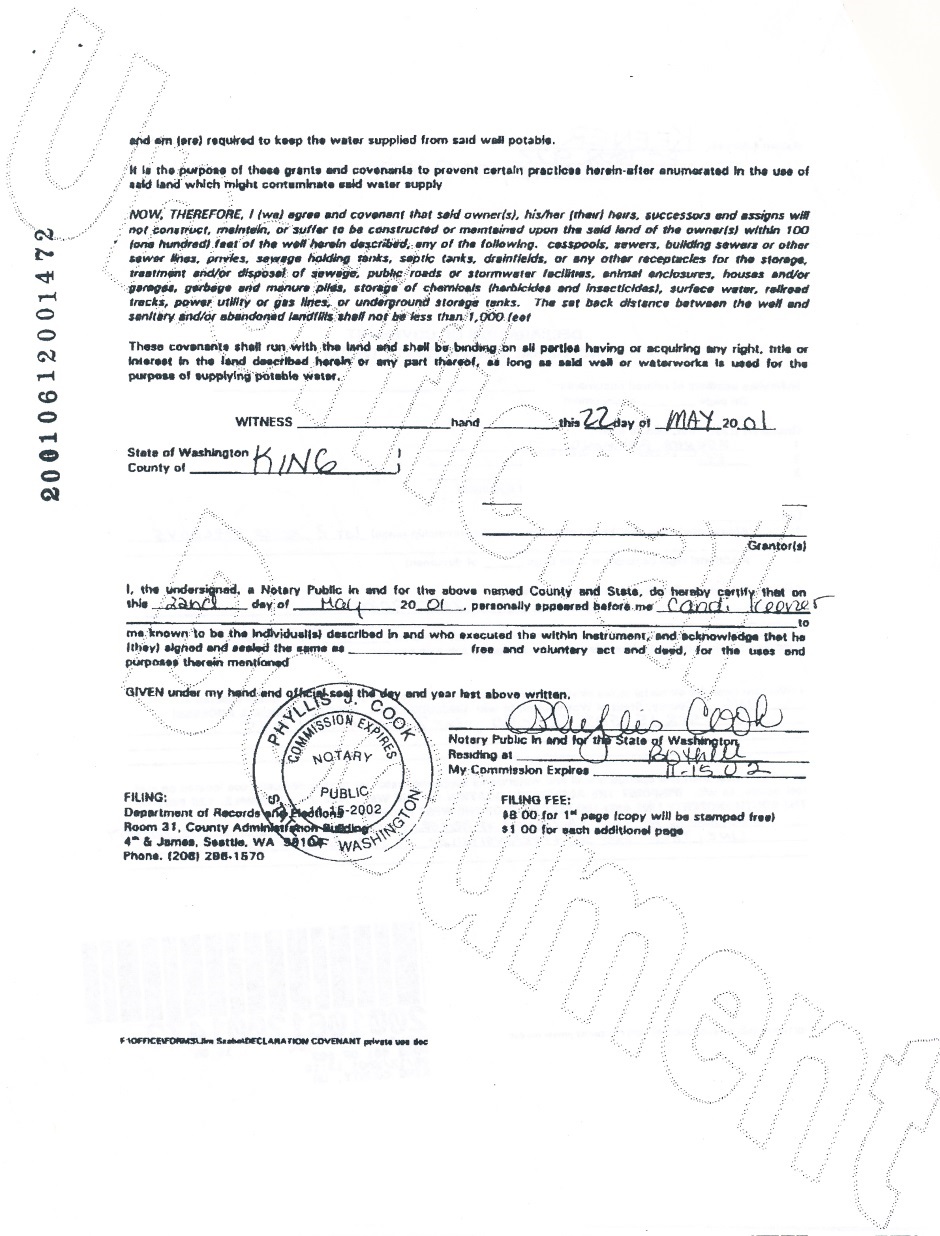
In the submission you need to include a test report to show that the well water is not contaminated...
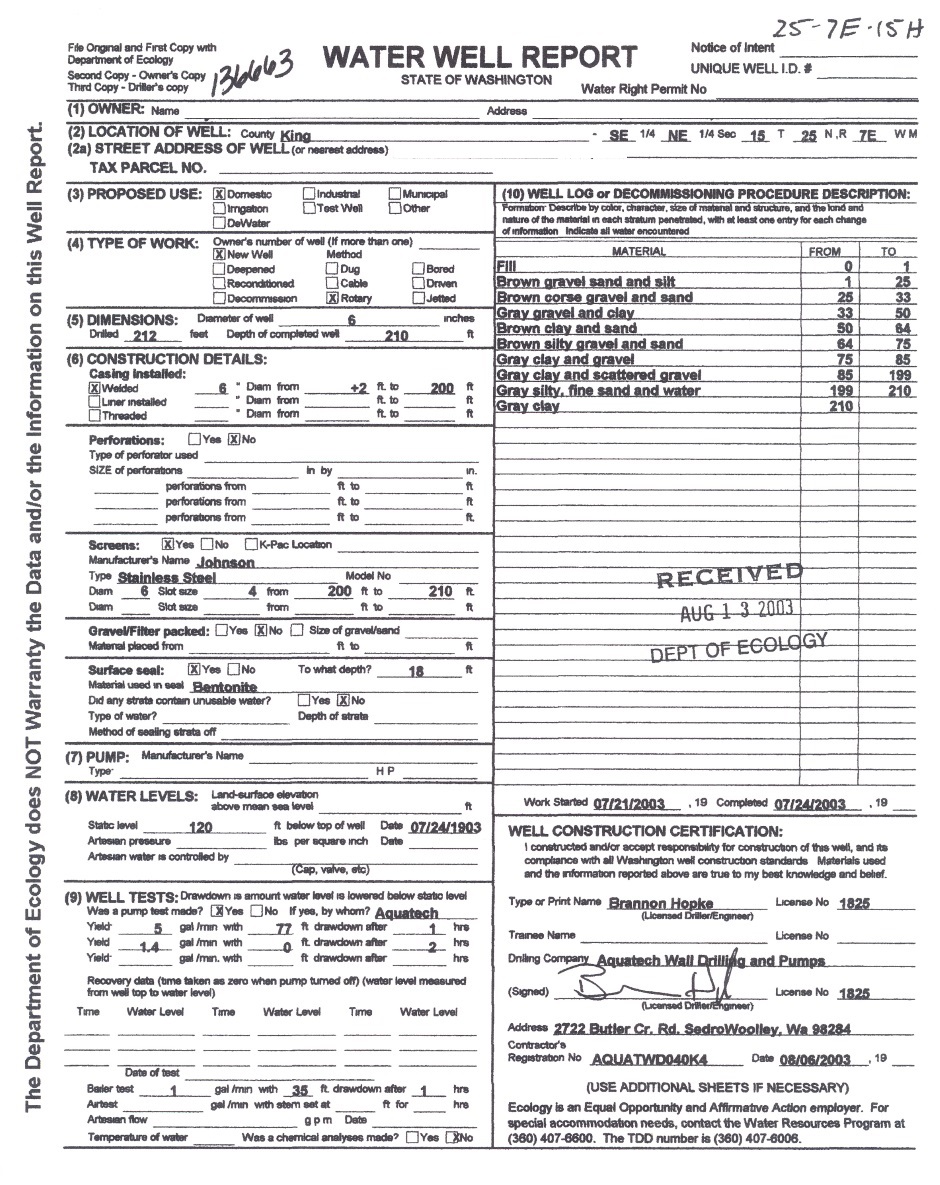
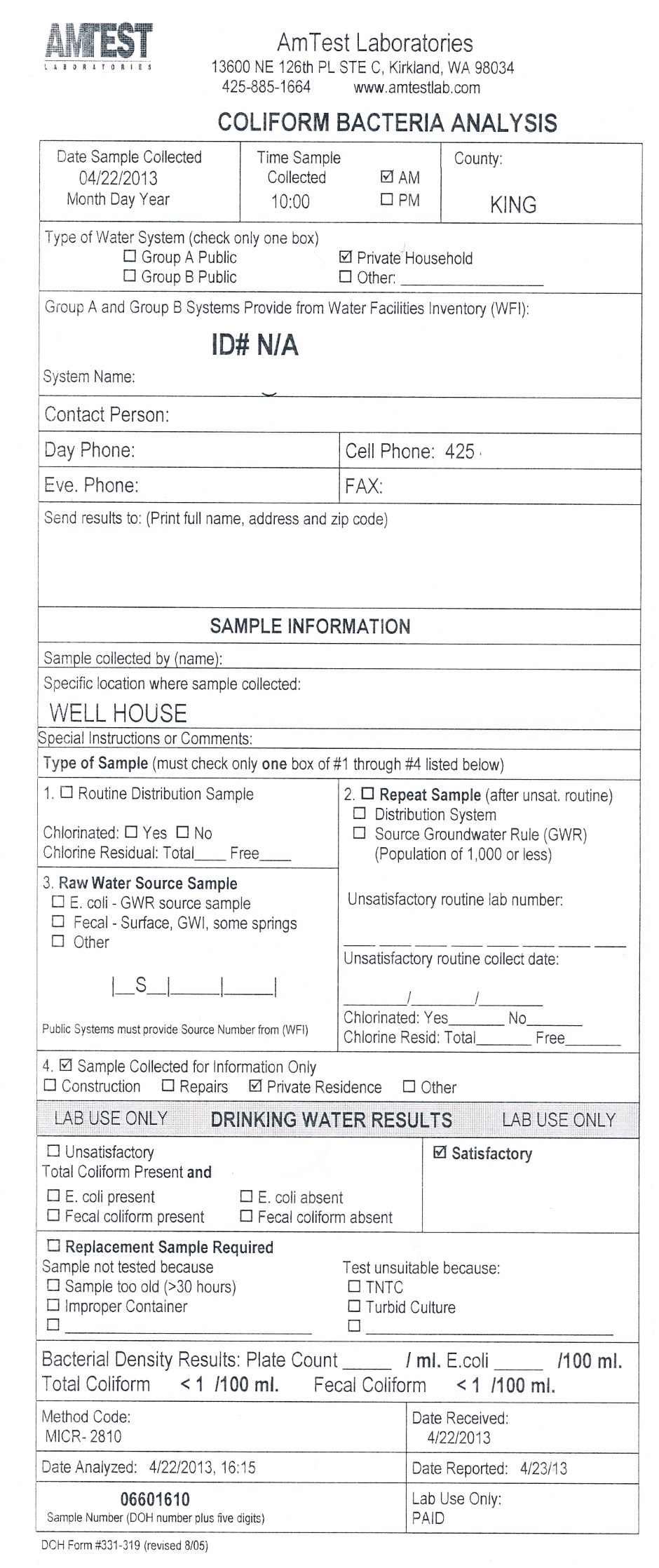
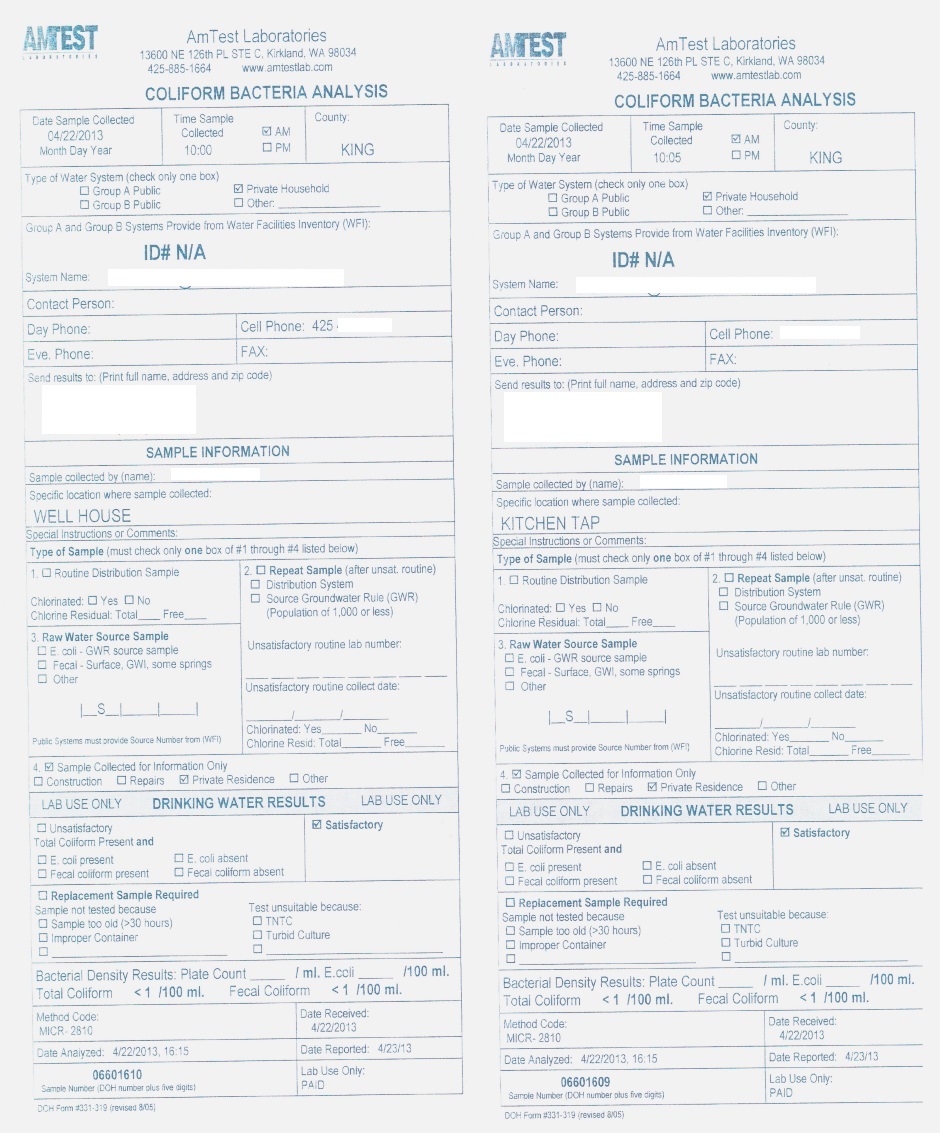
The submission needs a copy of the annual septic inspections that you have previously had performed. (There is actually a law that says all septic systems in Washington stage must be inspected by a licensed septic guy once a year.)
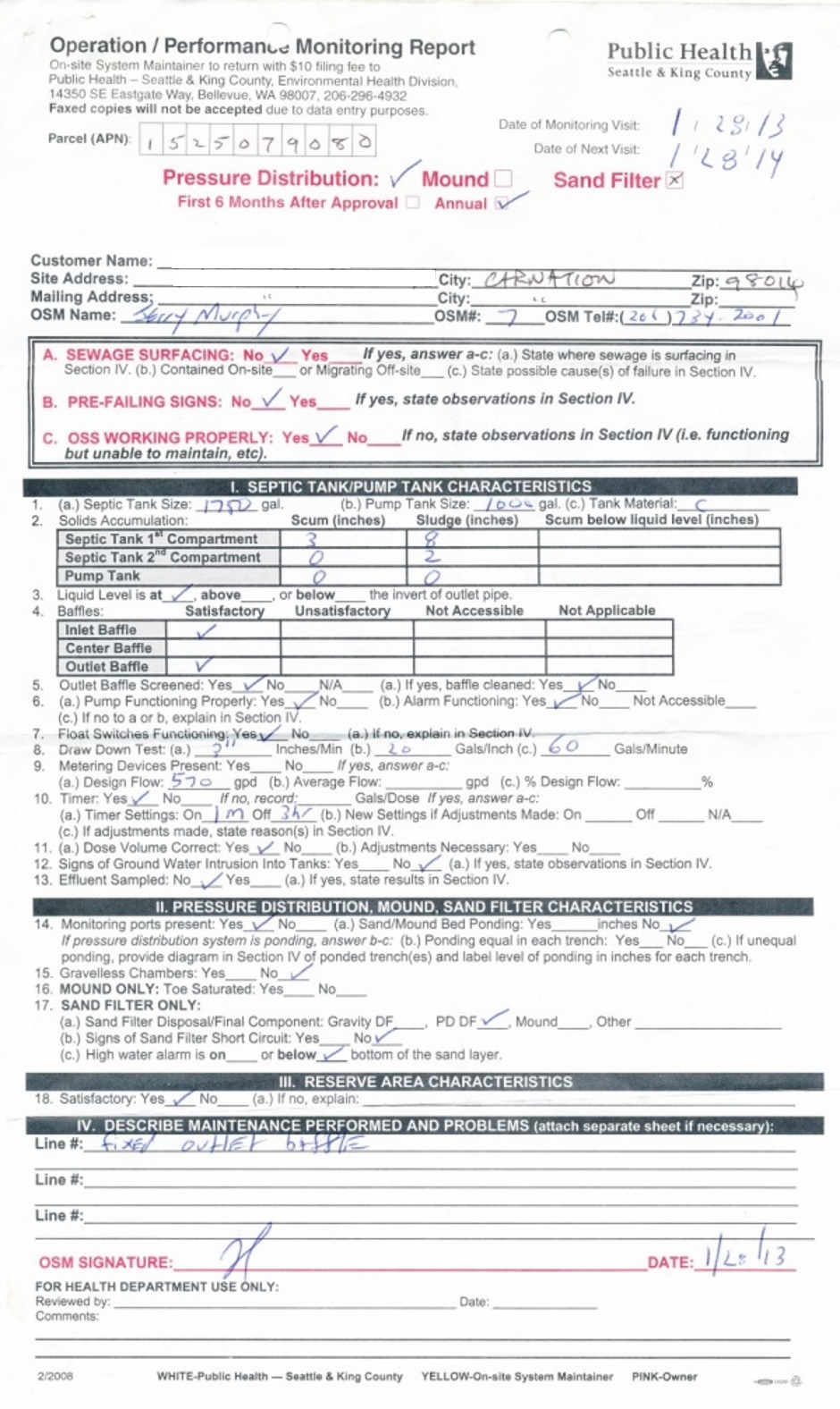
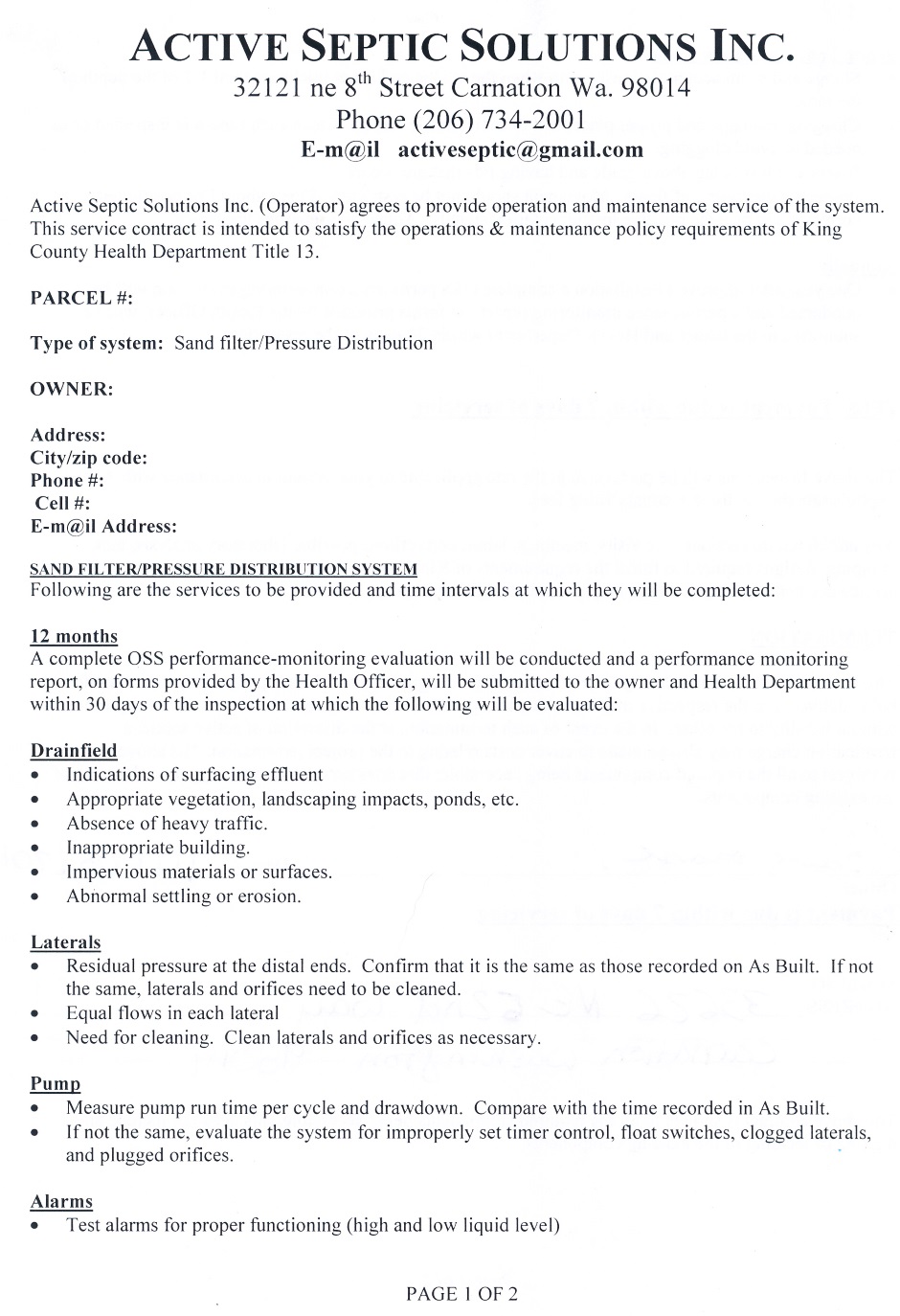
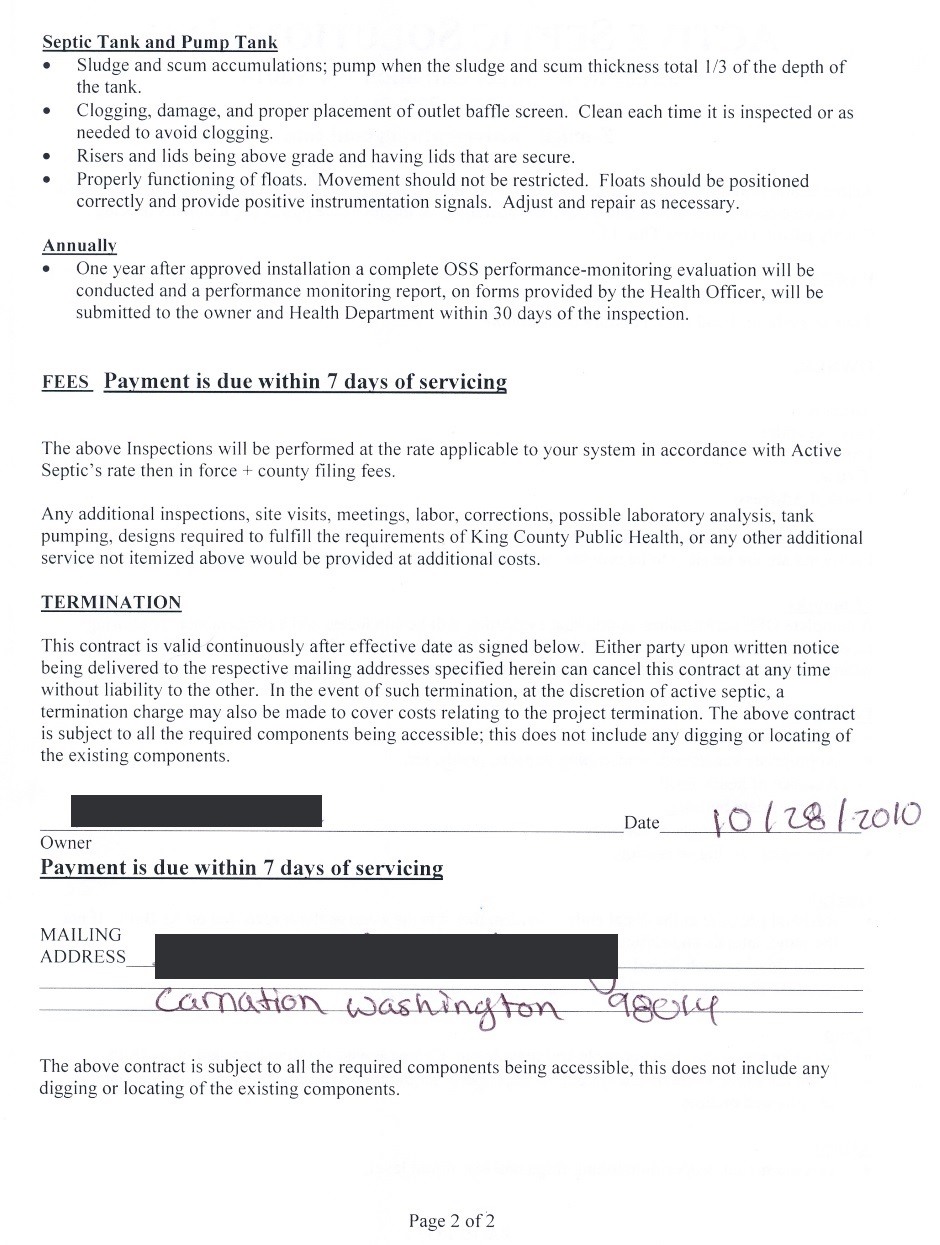
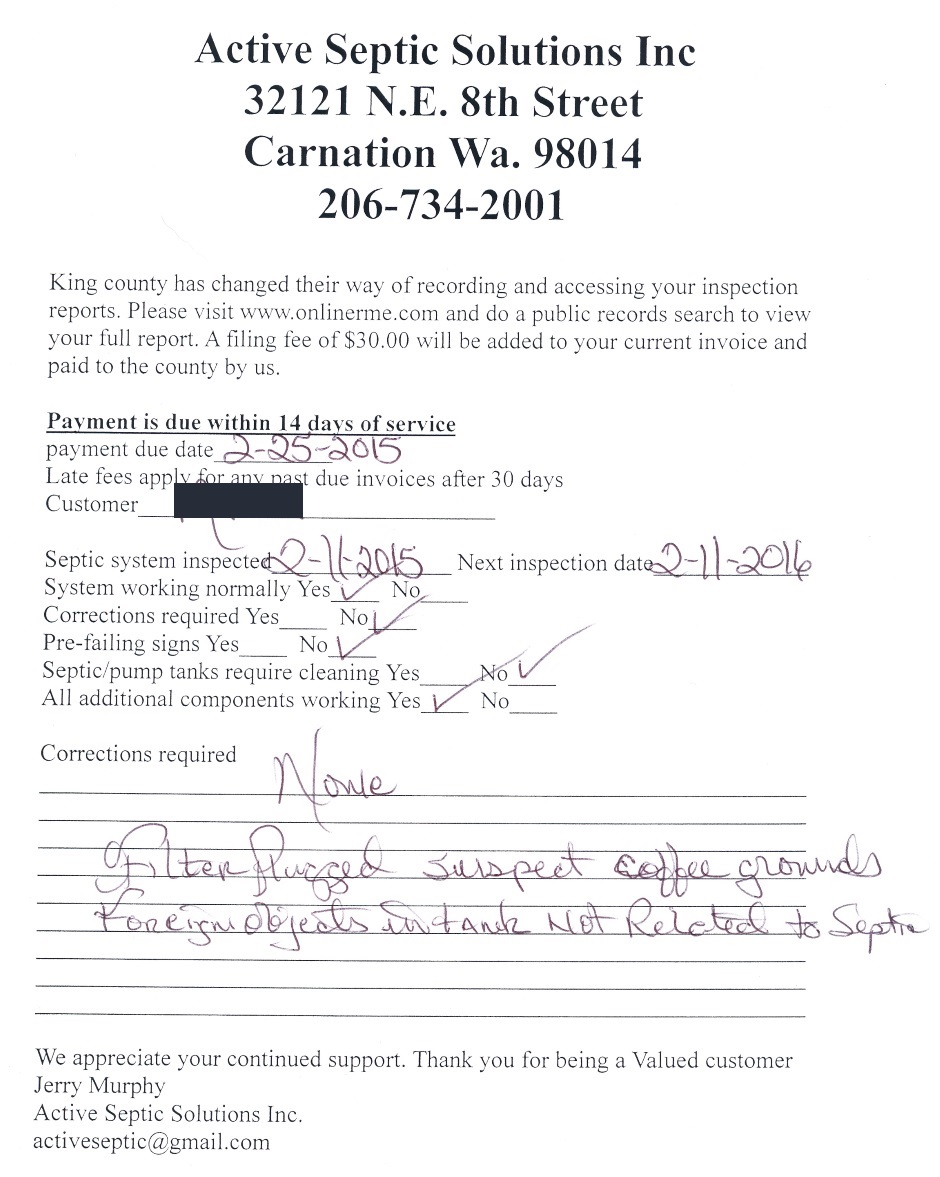
The submission needs the floor plans for the house so they can see how many bathrooms and sinks there will be in the house...
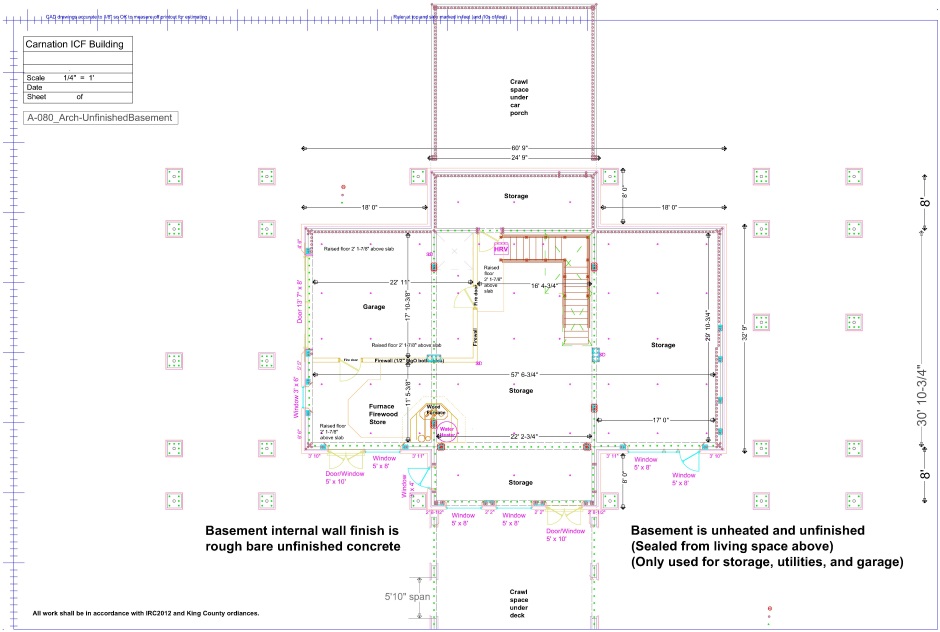
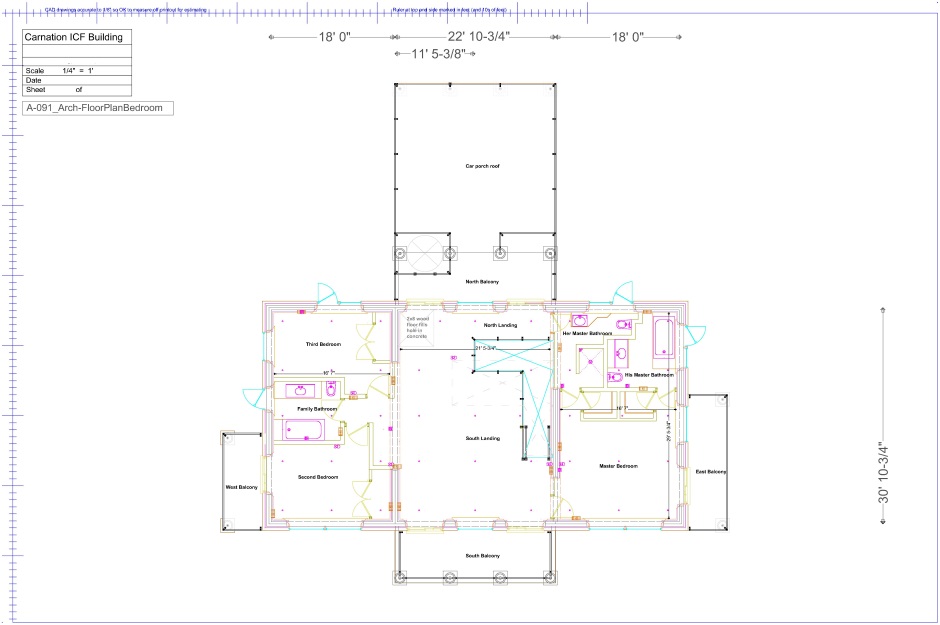
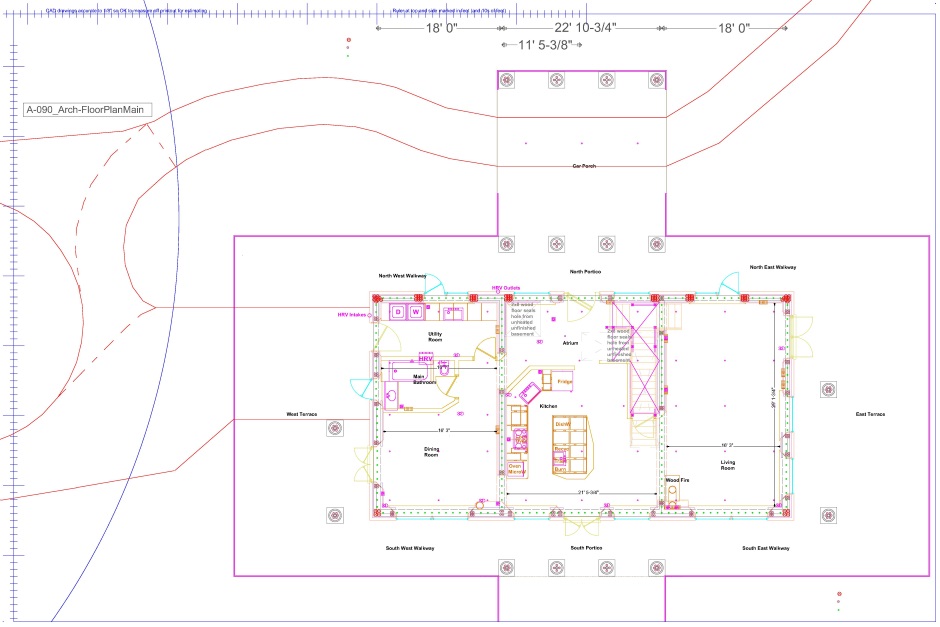
The submission needs to include the "as built" for the existing septic system...
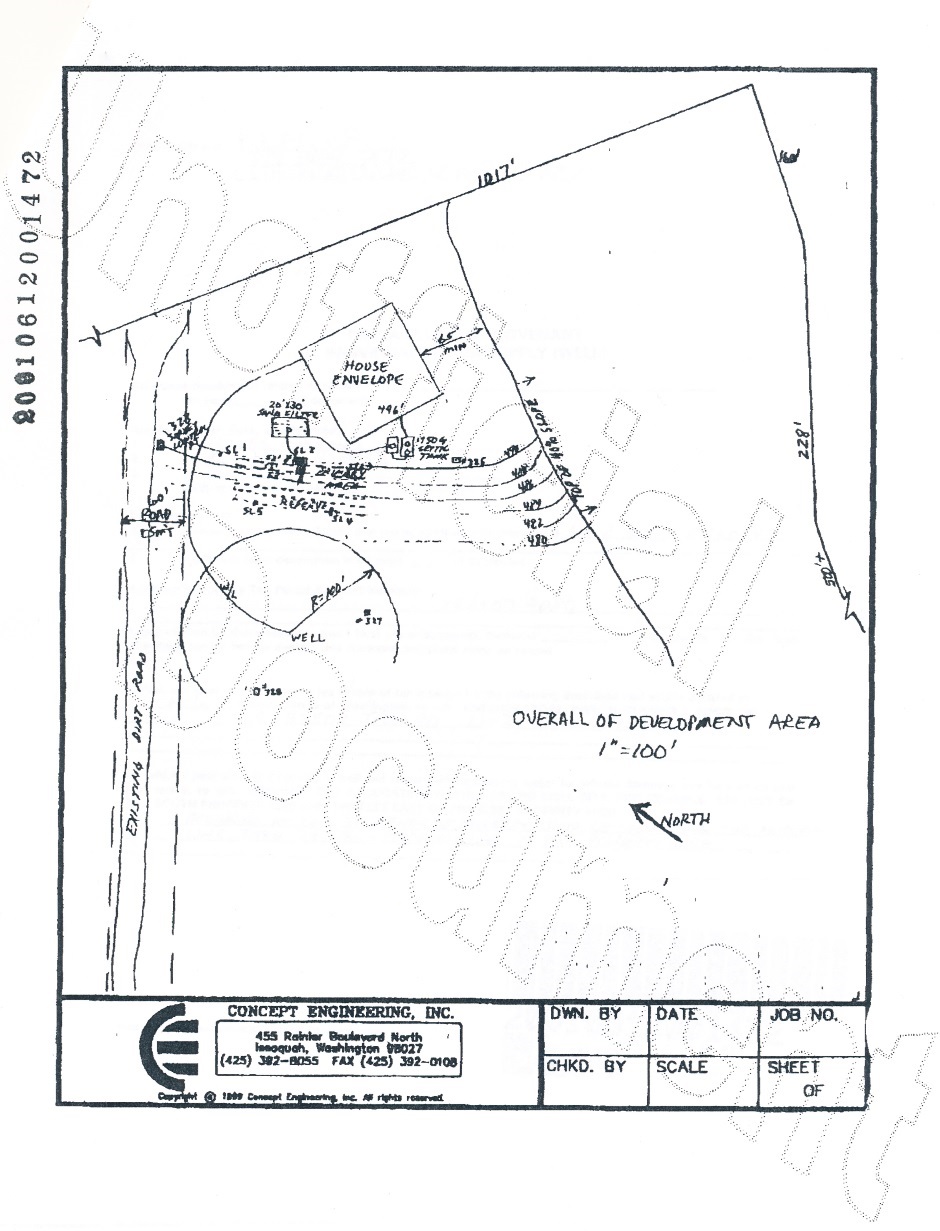
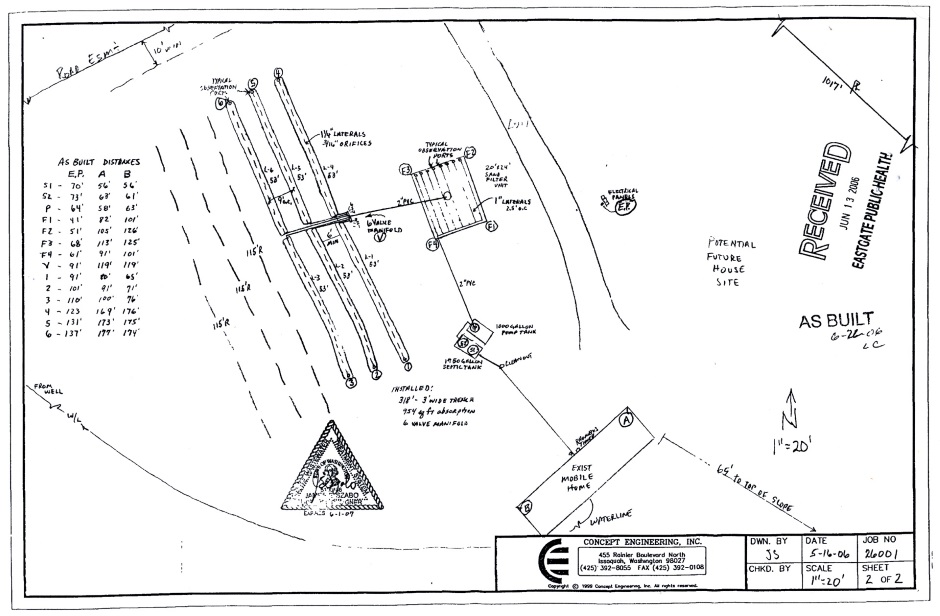
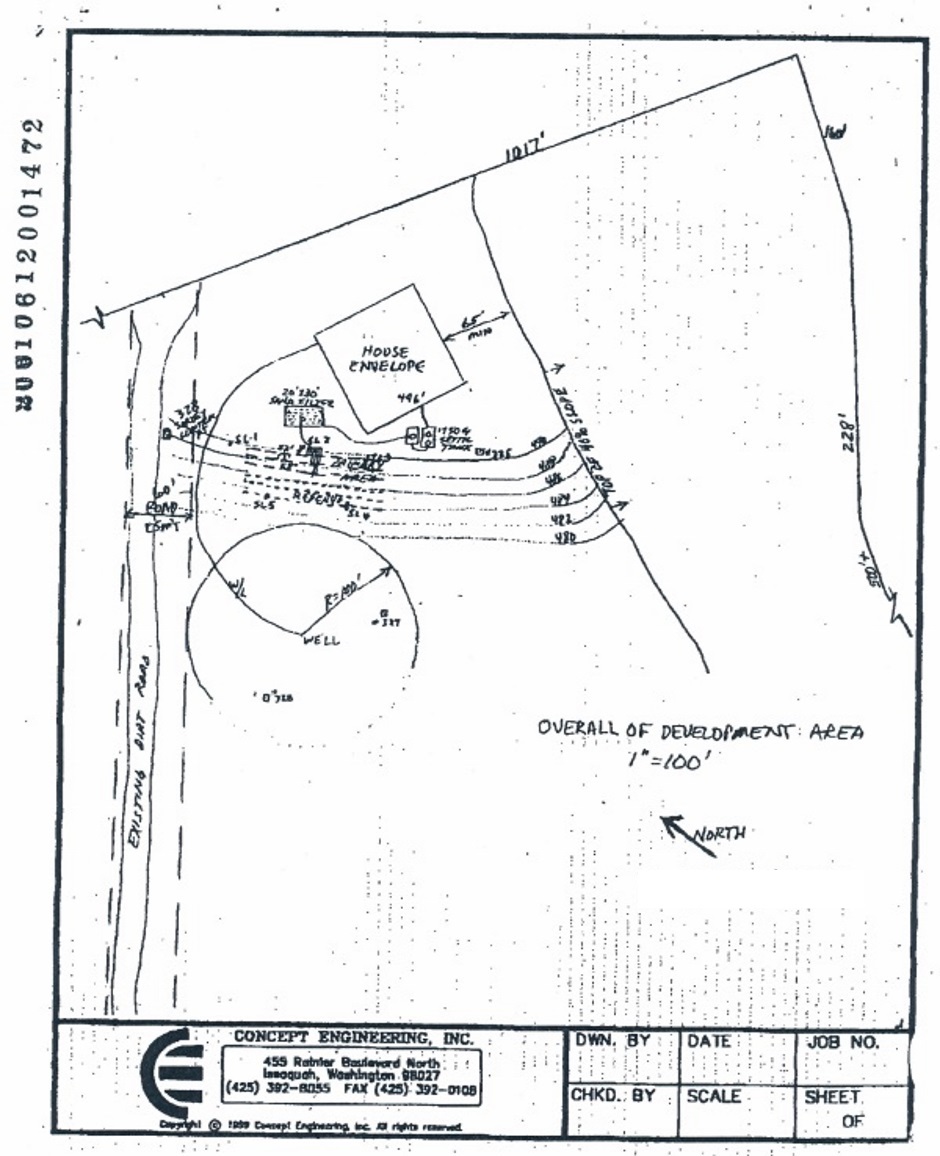
And last but not least the actual proposed design (submitted separately by the Licensed Septic Designer) needs to form part of the submission...
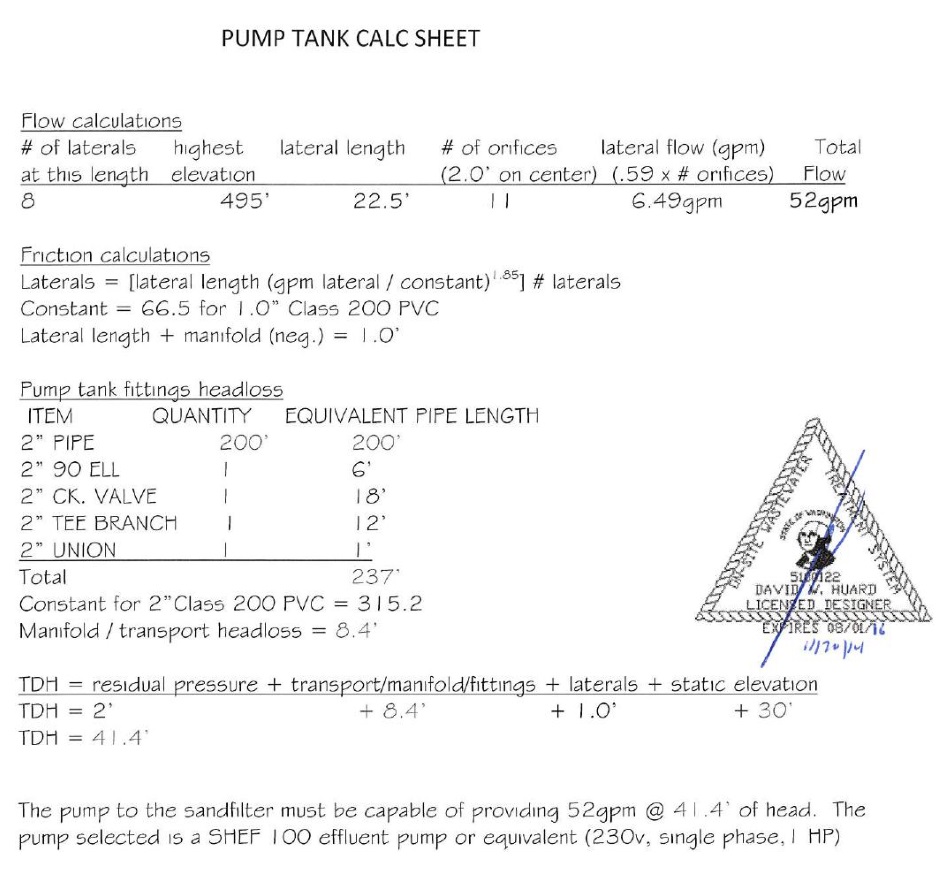
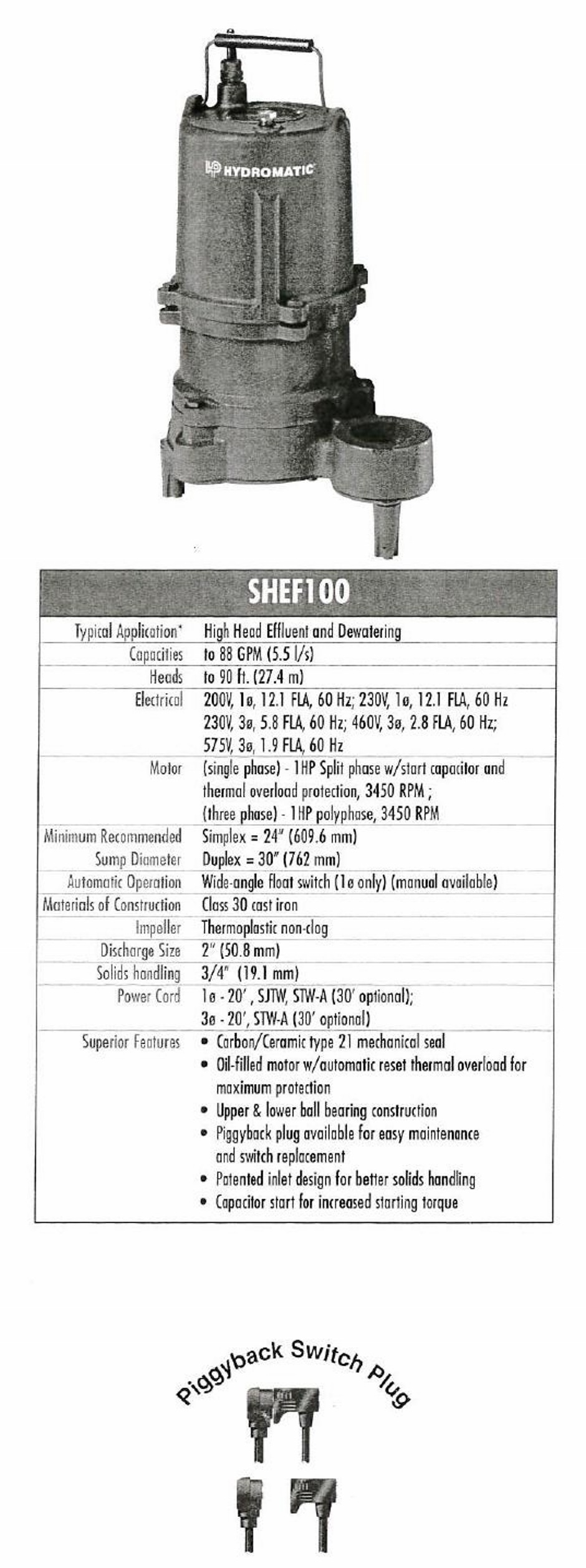
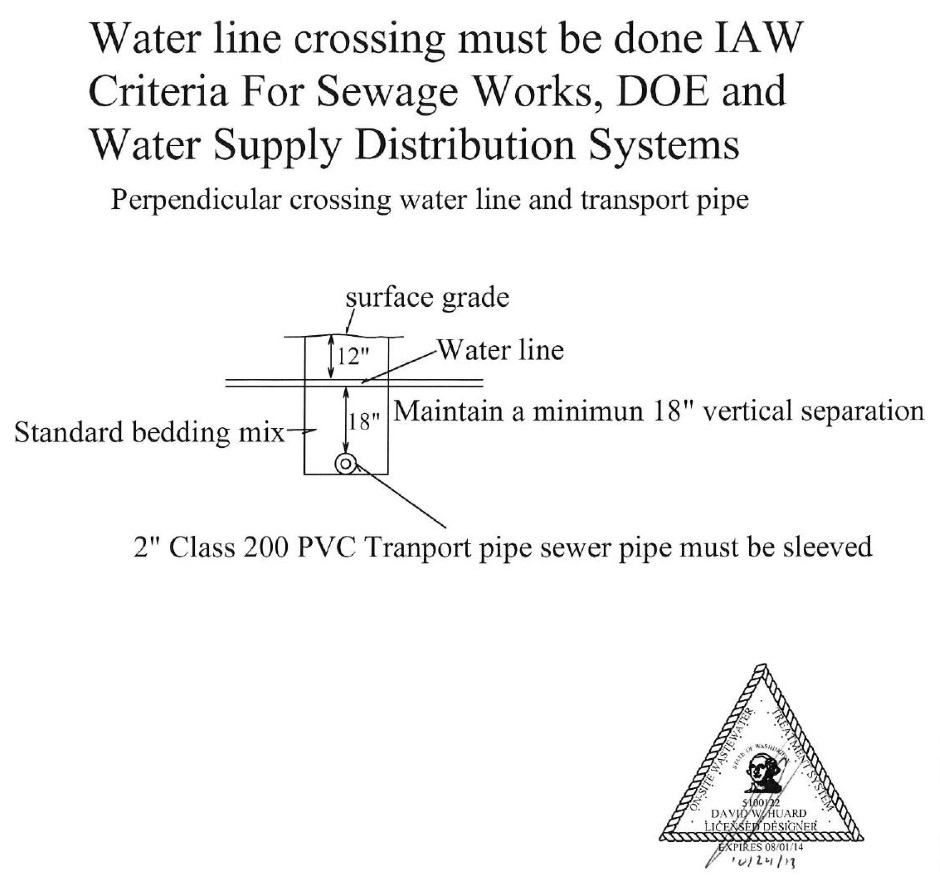
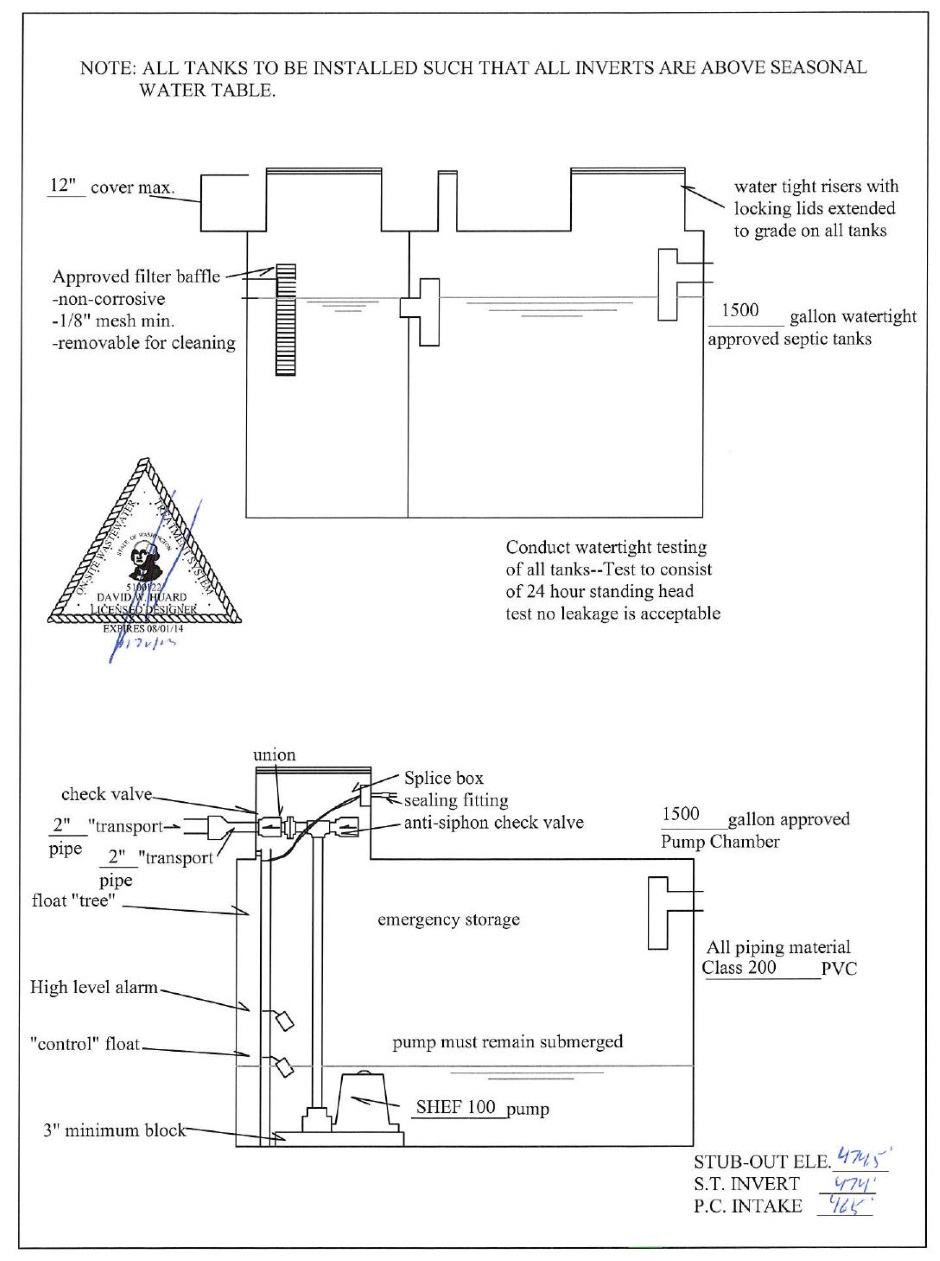
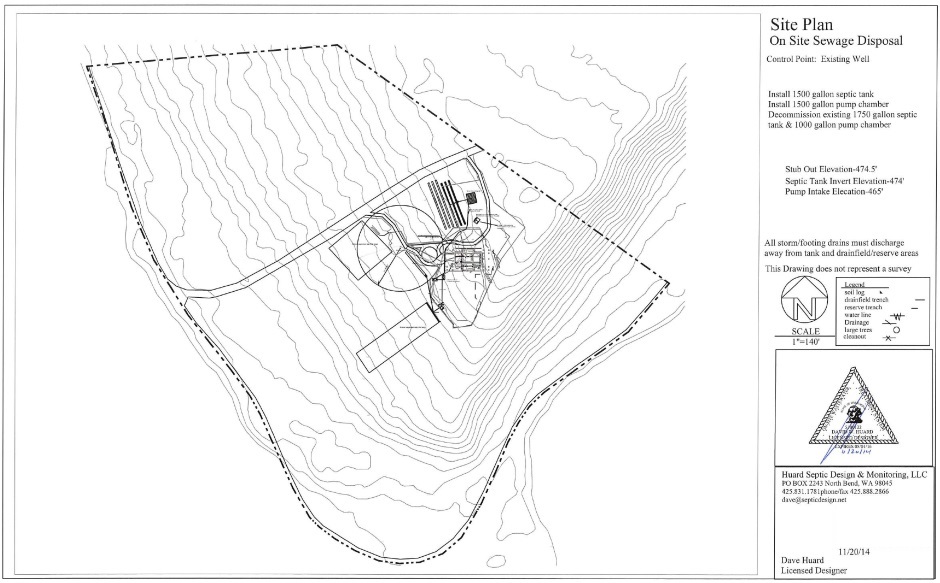
If the submission of the proposed design is successful then you should get an email and a copy of you submission with signatures and approval stamps. The approved proposed design is needed to give to the planning department before they will start the process of reviewing your house building permit application.
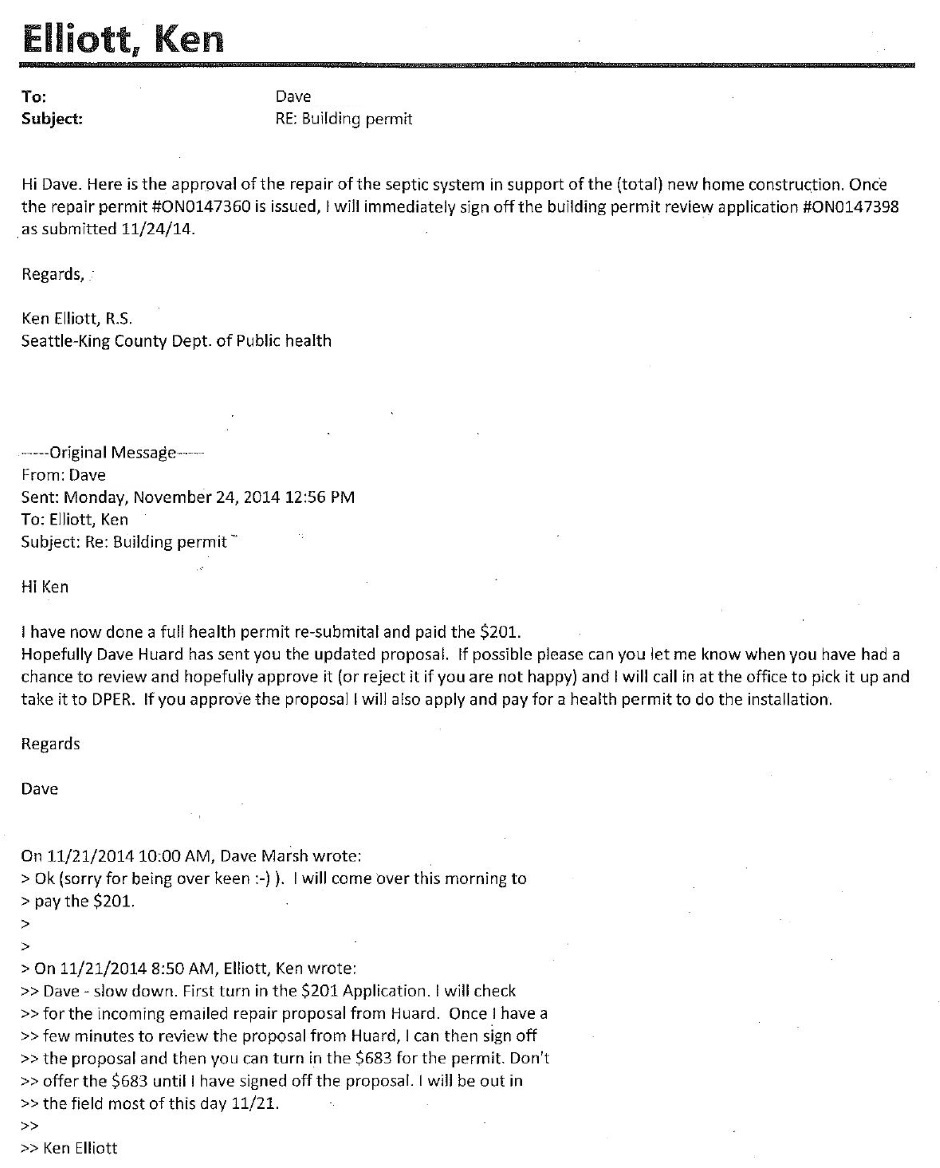
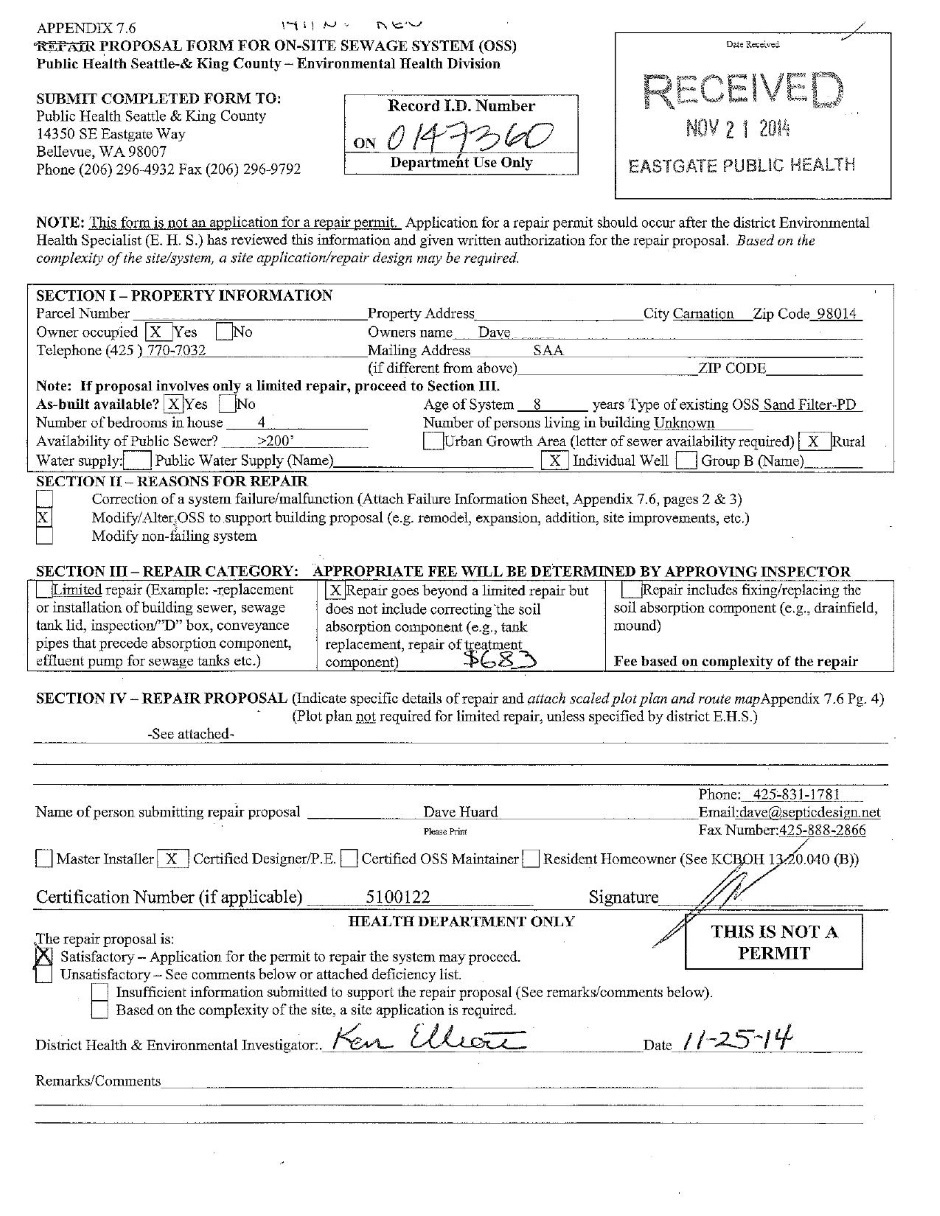
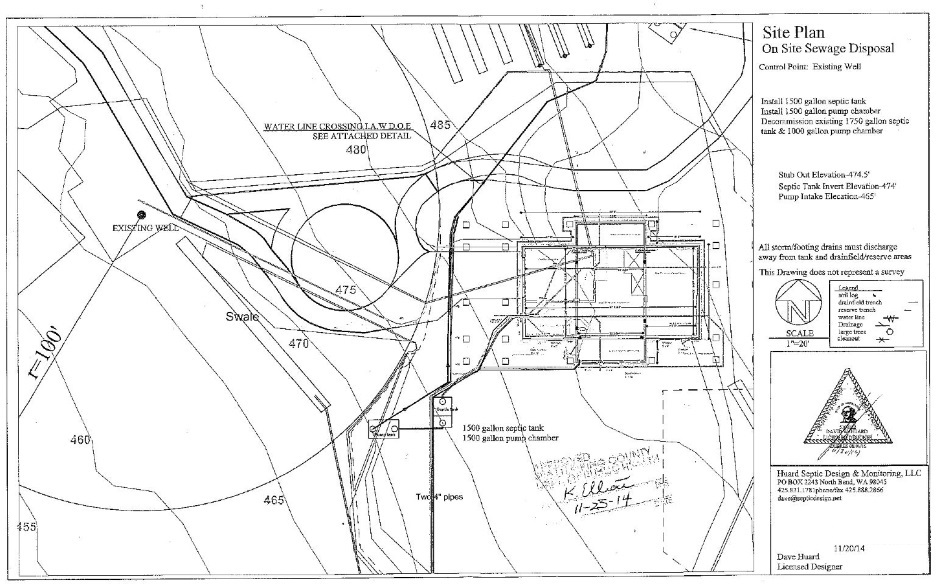
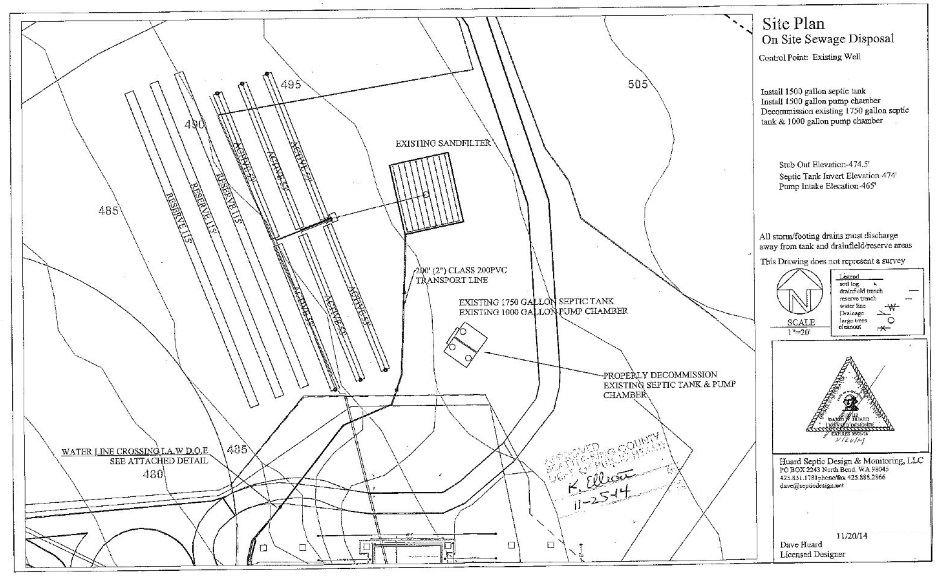
Component parts
Tank size
Your local health department will have specs on what size of tank is needed for a septic system. In my area it needs to be 1500 gallons or more and have two compartments. The first compartment (the largest chamber) collects most of the solids and the second compartment has mainly just effluent.
Note that whatever tank size you choose, you don't want the vertical height of the tank to be too high because that all adds to the pumping height. Better to get a short fat tank. You can get a 1500 gallon tank that only has a height of about 51" although a typical concrete tank is a bit taller.
A big issue when buying tanks is the shipping cost, so see what you can buy locally. It is probably best to just get a concrete septic tank from a local supplier. A local supplier is also more likely to be approved in your local jurisdiction.
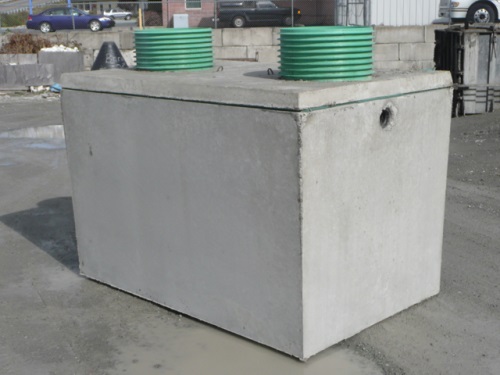
I my case I opted for a 1750 gallon two compartment concrete septic tank because the incremental cost between 1500 and 1750 gallon was not too bad. A particularly nice feature of the bigger tank is that it uses thicker concrete (4") for the walls than the smaller tank (which has 3" thick walls). The price with shipping is about $1,700. It is supplied by...
Berg Vault Company
2308 Cedardale Road, Mount Vernon, WA 98274
360-424-4999
http://www.bergvault.com
Peggy@BergVaultInc.com

Note that the output hole is 3" lower than the input hole. This must be allowed for when deciding on how much lower in the ground the pump tank needs to be compared with the septic tank.

Effluent Pump to sand filter
The good news is that when you have a full dual compartment septic tank and a separate pump tank down by the house then it is only "effluent" (ie dirty water) that you are pumping rather than sewage that has solids. That reduces the cost of the pump. The bad news is that you need some extra pressure to force the water through the sand filter and that increases the cost of the pump.
My pump is a "SHEF 100".
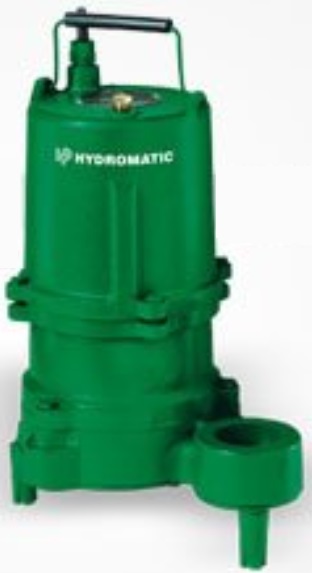 Details here .
Details here .
As it is 230V, it connects between L1 and L1 via a special plug. The float switch also connects using that plug type.
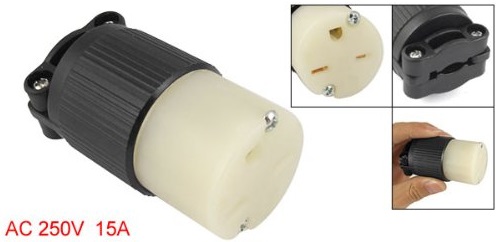 Details here .
Details here .
Check valve
A check valve goes in the 2" PVC exit pipe from the pump at the pump end of the pipe and is used to prevent sewage in the pipe flowing back into the tank when the pump is not on. They cost about $25.
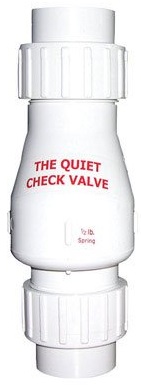 Details
here .
Details
here .
The design also calls for a second check valve on the free end of the pipe in the tank.
Alarm system
In addition to the float switch used to turn the pump on and off there needs to also be an alarm float switch to warn if the tank gets to nearly full. This tells you if the pump that empties the tank has stopped working.
I decided to use a float switch operating at 110V and route a wire back to the house to light a bulb to indicate that the level is too high.
 Details
here .
Details
here .
It is however a requirement that there must at minimum be an external light visible when standing on the pump tank and there must be an audible alarm.
Implementation notes
The 2" schedule 40 PVC pipe that goes from the pump tank to the sand filter carries high pressure effluent. It is important to use high pressure water PVC connectors on this pipe. Do not use PVC DWV type connectors. You will probably not be able to find Wye connectors in high pressure fittings so if as in my case you need a wye connection (with the two shutoff valves that for a switch between the old and new tank set) then you would need to use a T piece and a 45 degree piece. Even better is to separately tap the two pipes into the vertical pipe that goes up the side of the sand filter and this is what I chose to do.
Caring for your system leaflet
King county publish the following useful leaflet to let you know how to look after a sand filter septic system...
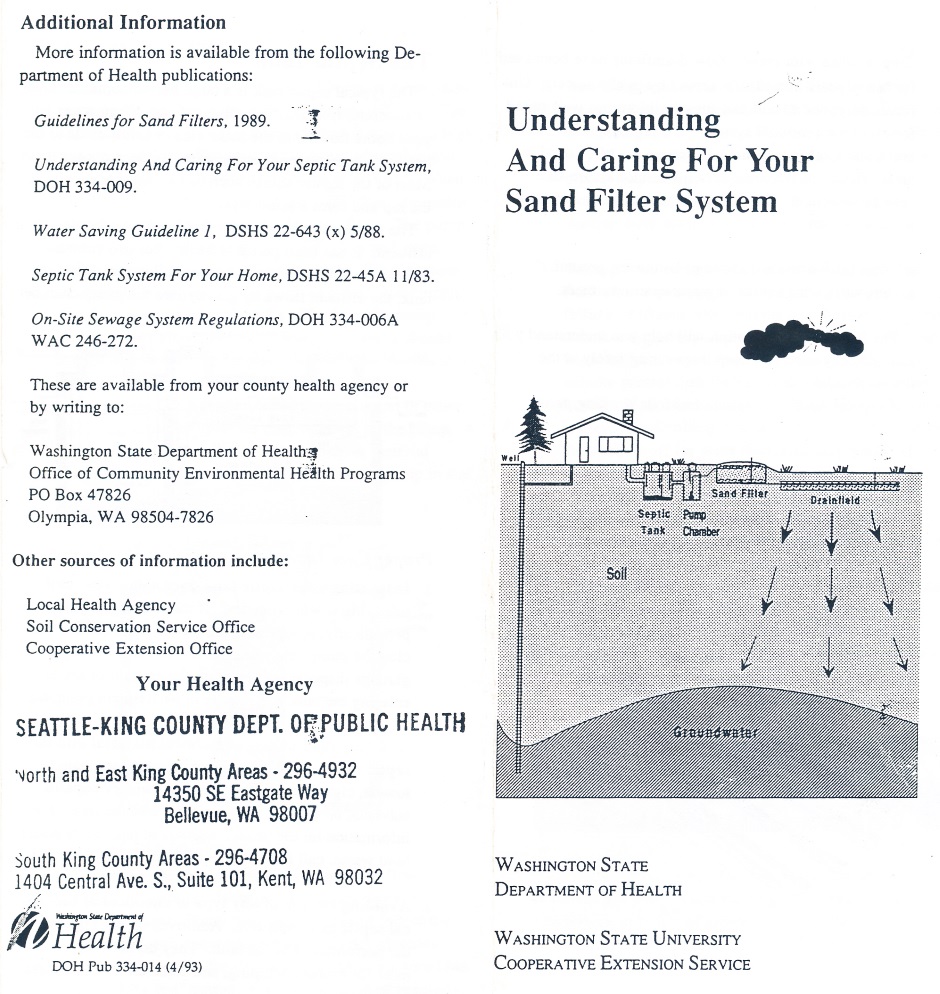
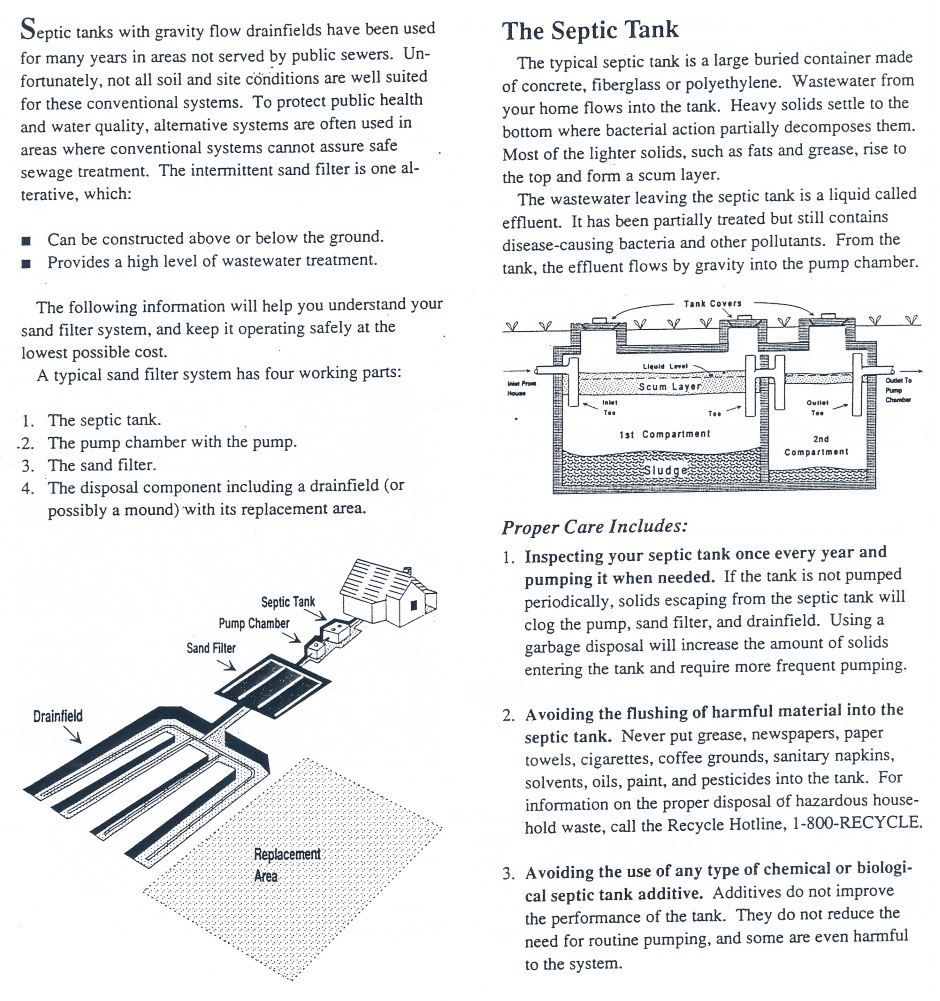
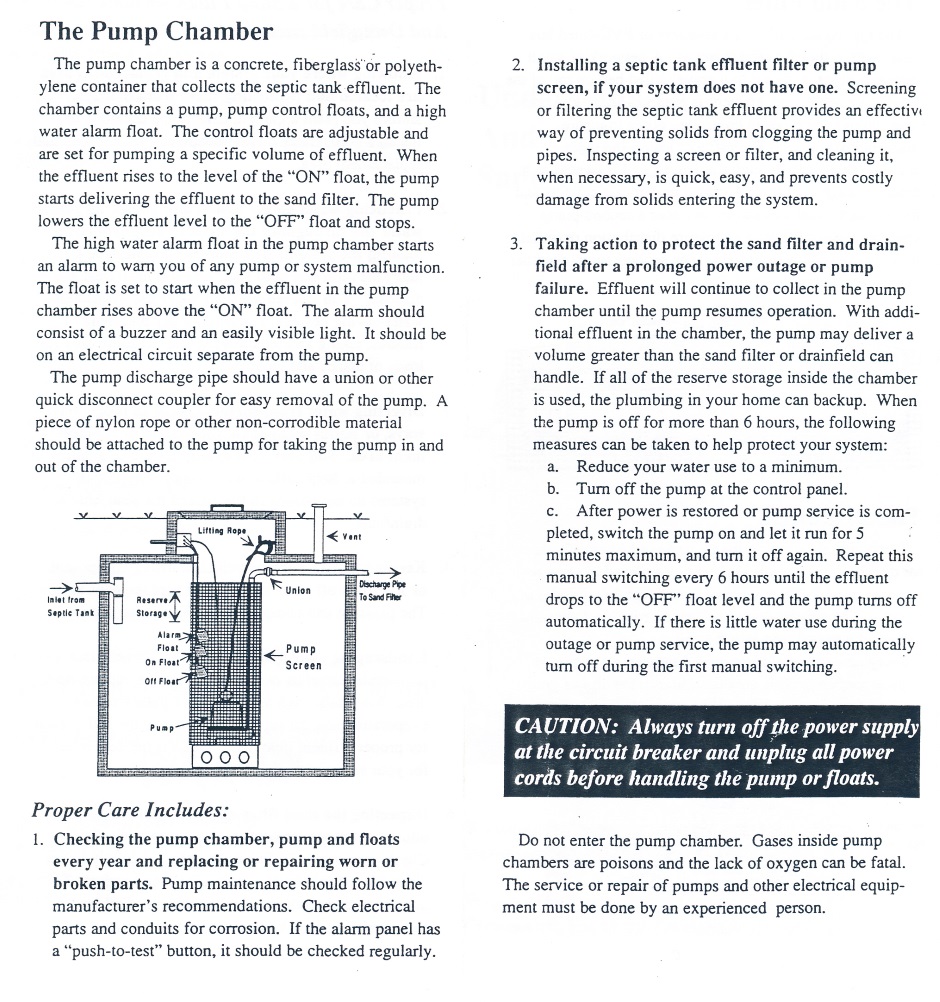
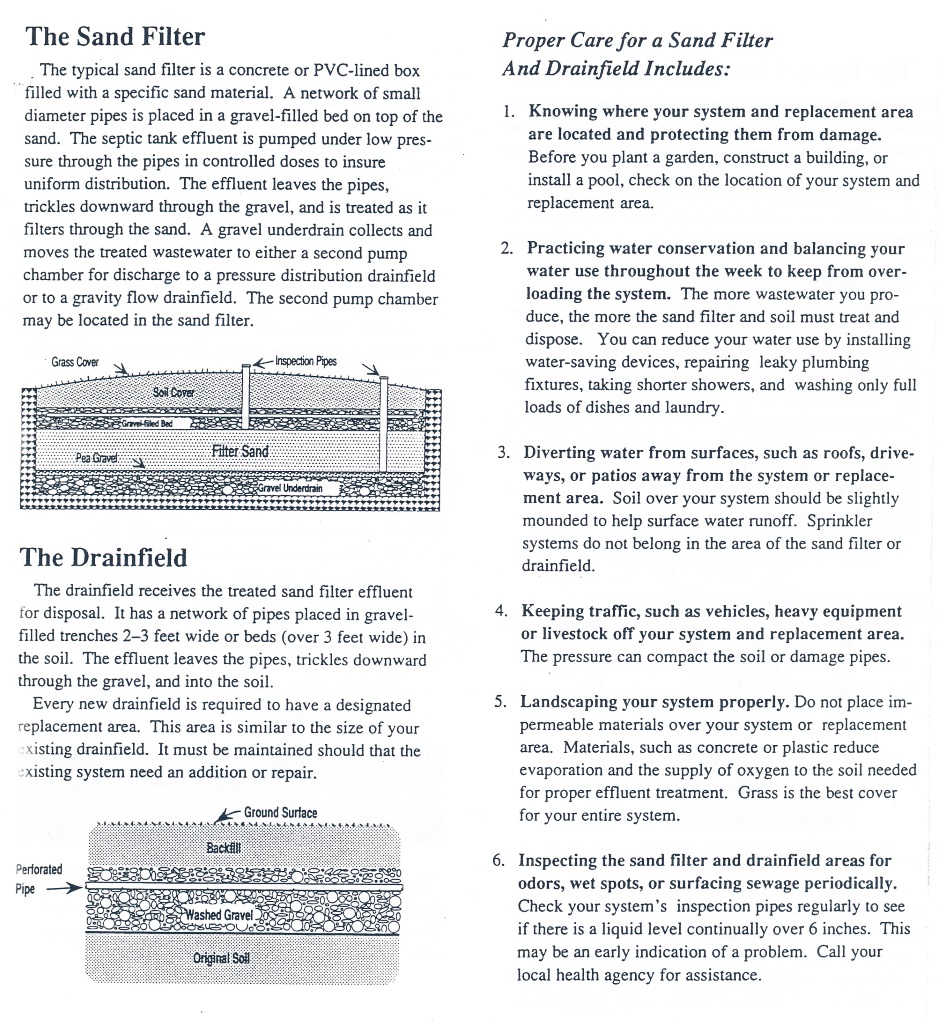
Implementation
Tank Excavations
Excavating is easiest with an excavator or backhoe.
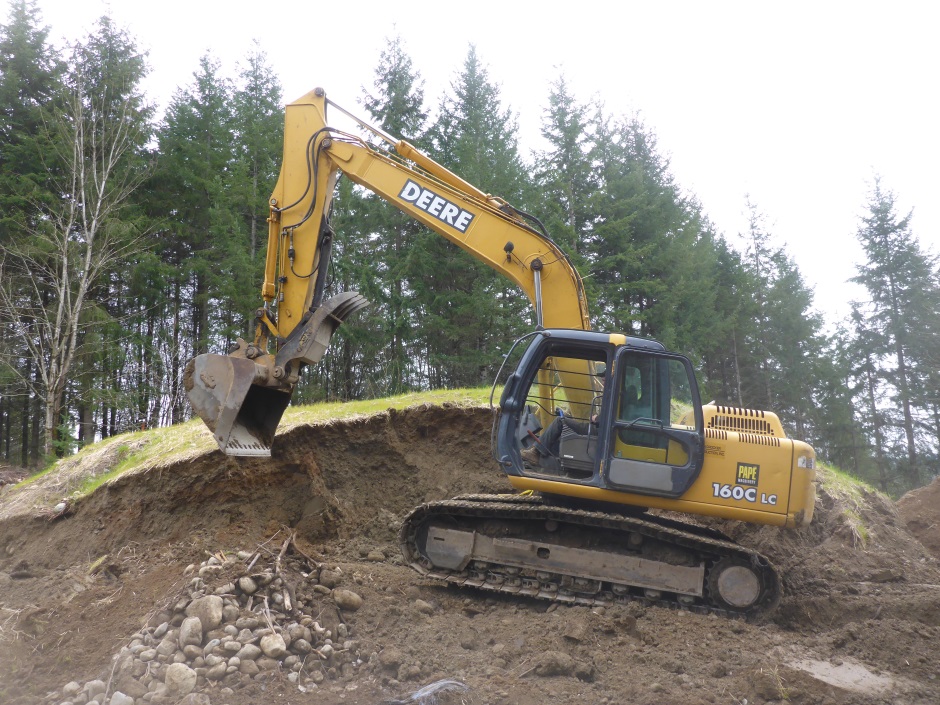
You can do it by hand if you want the exercise, but if you hit a big rock that requires extra effort.
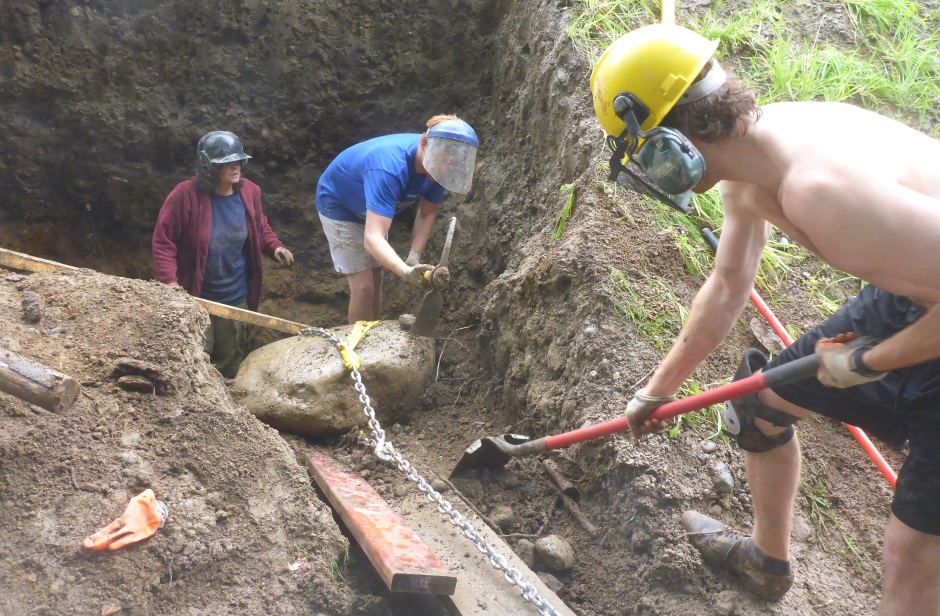
The best way to assess the depth and make sure the depth is even across the whole bottom is to setup a self leveling laser at reference grade level and then use a sick with a white plastic card on the end. The length of the stick to a mark halfway up the card should be whatever you have determined is the required depth (from your CAD drawings).
The pump tank wants to be 2 or 3 inches lower than the septic tank. You need to maintain at least a 1/4" per foot pipe slope from the output of the septic tank to the input of the pump tank.
Get the soil at the bottom of the excavation completely level all around the outside where the walls of the tank will sit. This is best done using the laser line on the stick that has the white plastic card. Keep moving the stick to different places and check the laser line is at the same place. In the center of the excavation (where the middle of the tank will be), you need to excavate down an additional couple of inches. This is so that most of the weight of the tank is taken by the concrete walls of the tank rather than the concrete bottom of the tank.
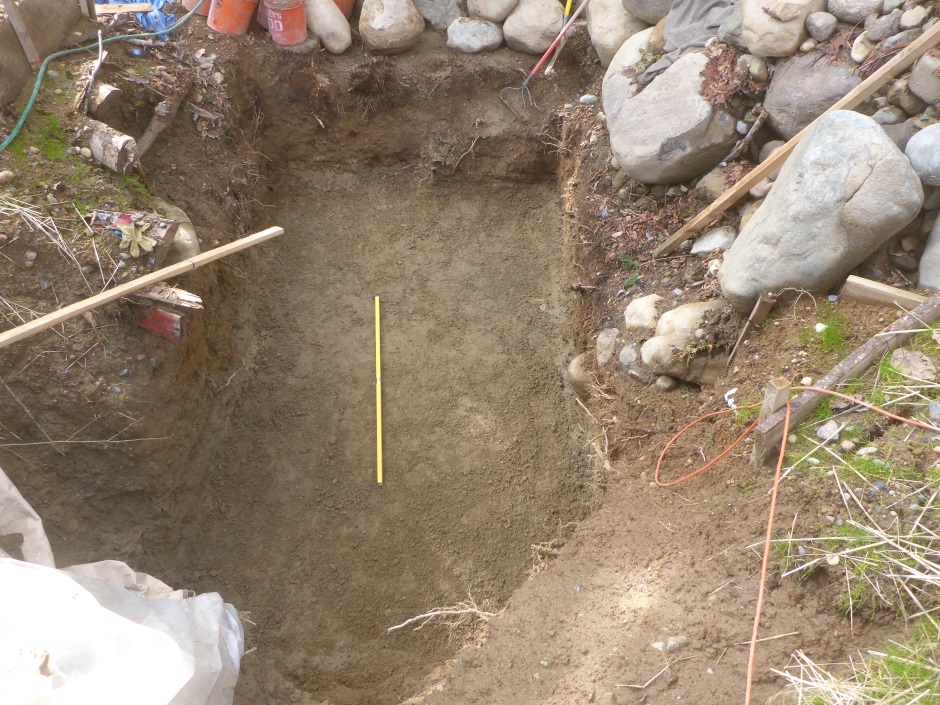
A wooden frame can be useful to help guide the tank into the hole without caving in the sides, but is typically not necessary.
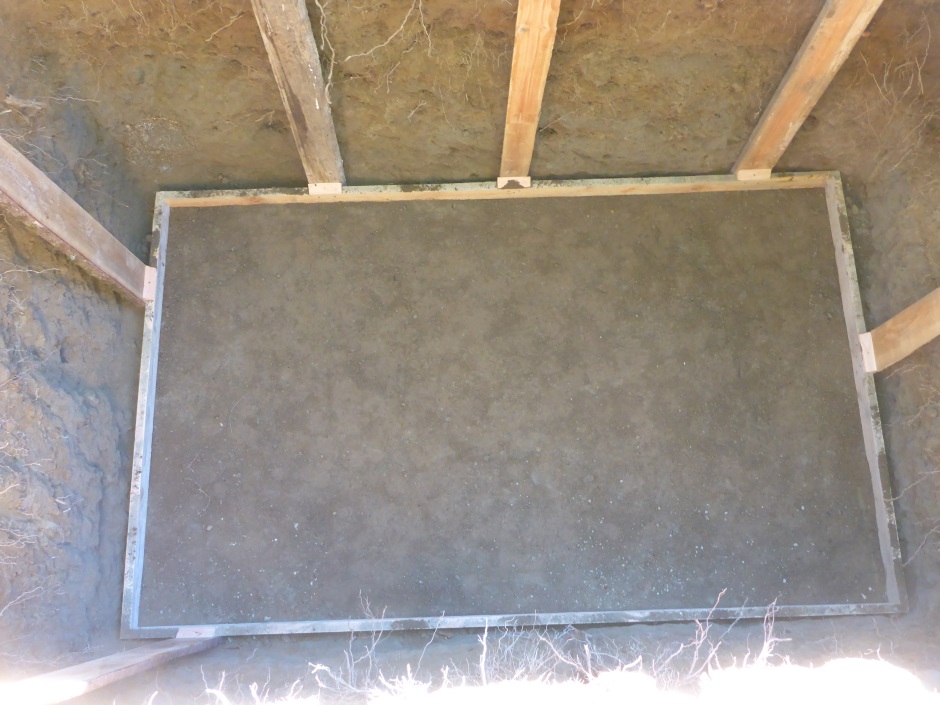
Once the soil is level (with a dip in the center area), add about 6" of gravel. Level the gravel using the laser stick method. Note that the thickness of the gravel bed needs to have been allowed for in your calculations about how deep the hole needs to be. In my case I needed to get the bottom of the septic tank at 7'11" below ref grade and the bottom of the pump tank at 8'2" below ref grade.

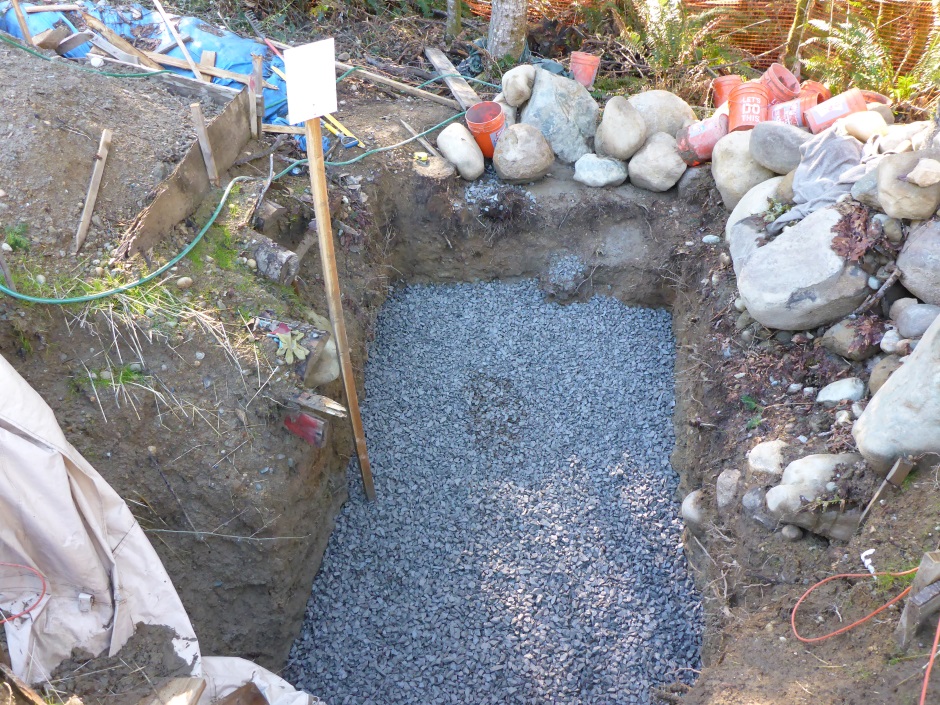
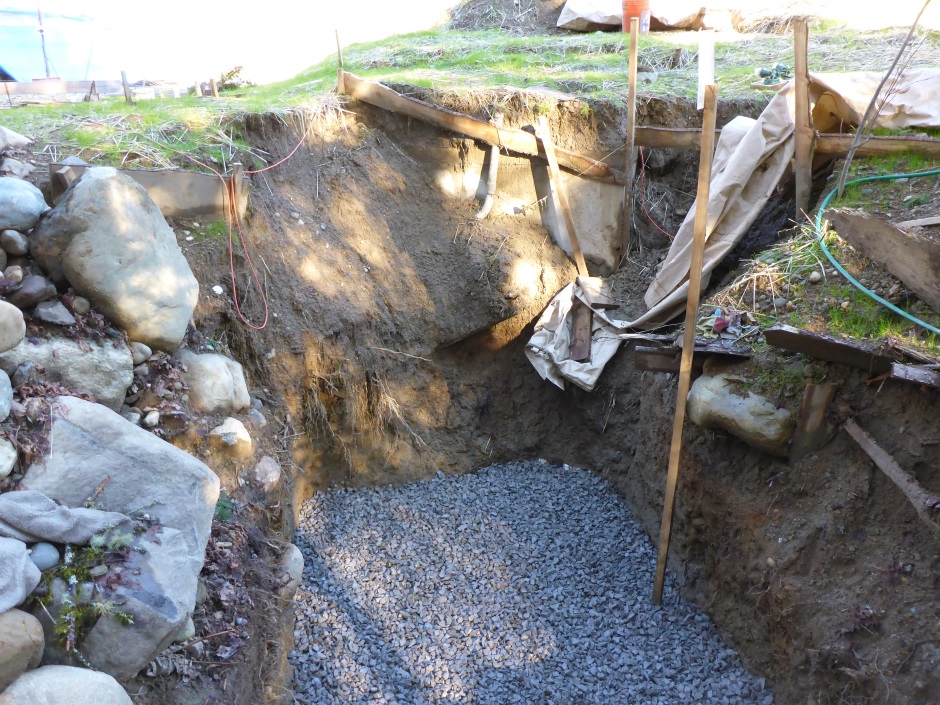
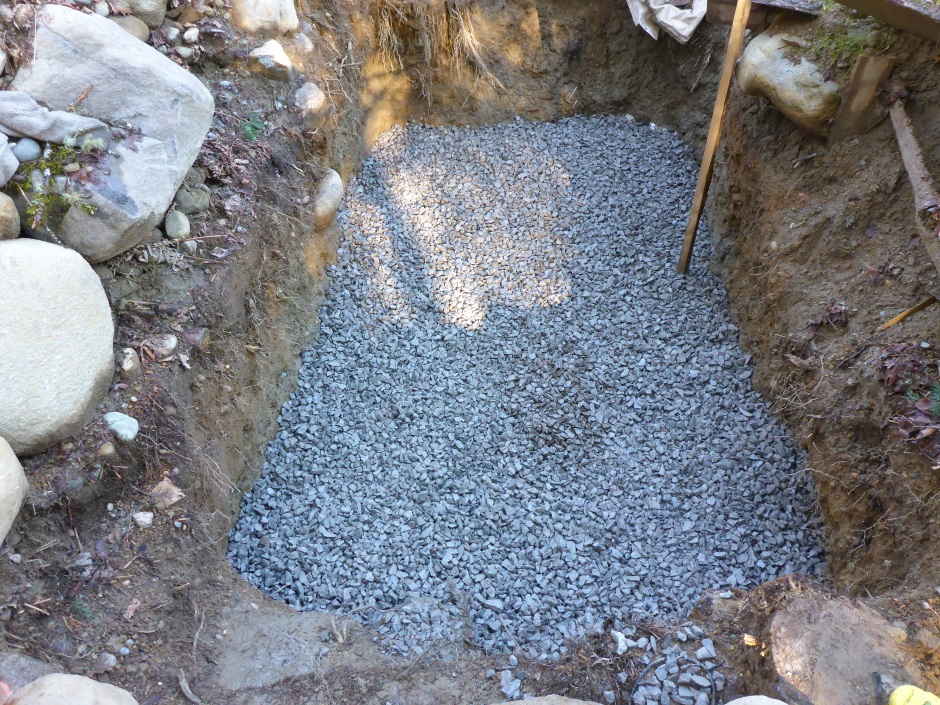
Septic Tank
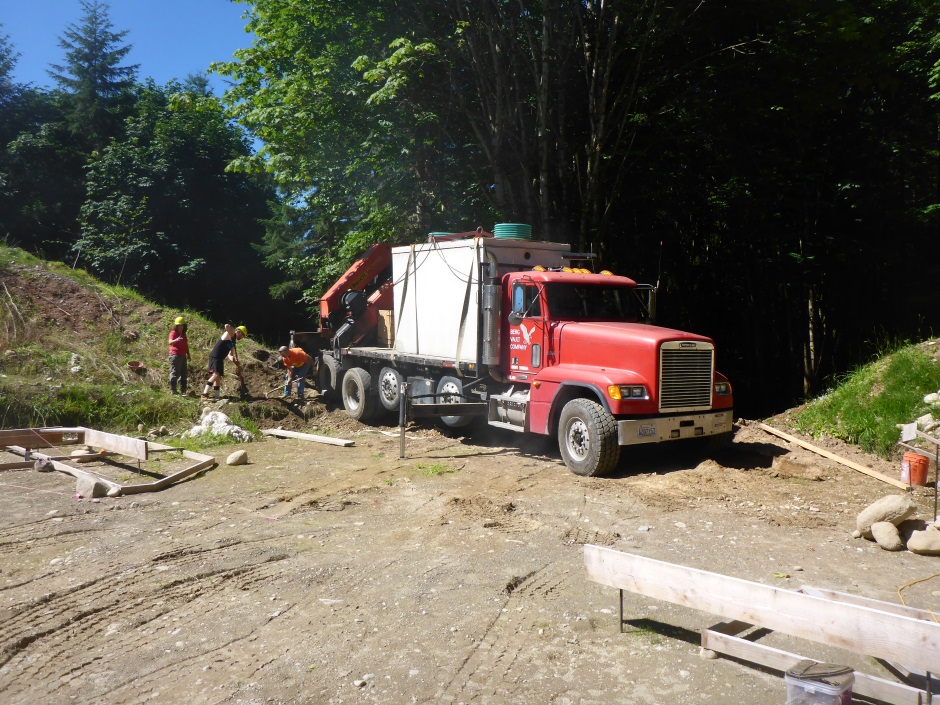
The delivery truck has outriggers an sometimes it is necessary to do some digging and moving of rocks to allow the outriggers to be extended.
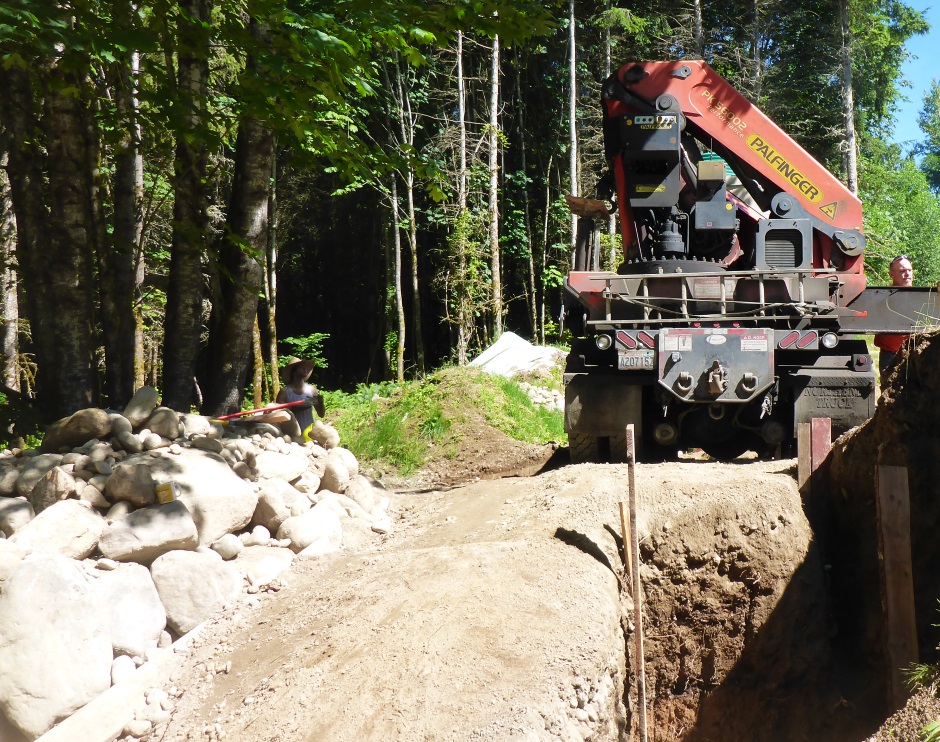
There is a crane on the back of the truck, but it only has a limited reach so the back of the truck needs to be fairly close to the hole. If you try to over-reach then the entire front of the truck will rise up into the air due to the weight of the tank (I have seen this happen and it is very spectacular, but dangerous).
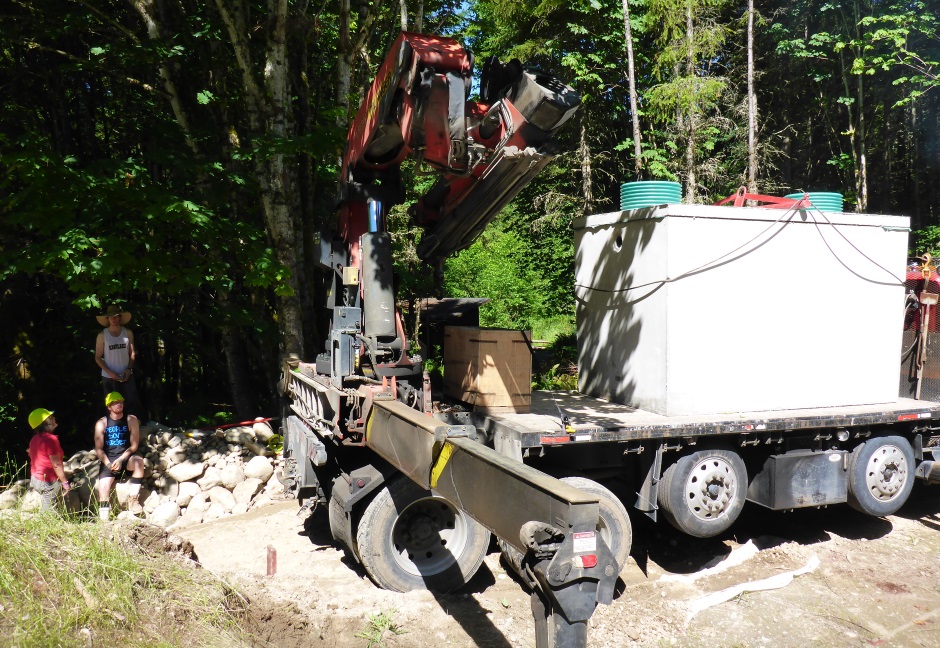
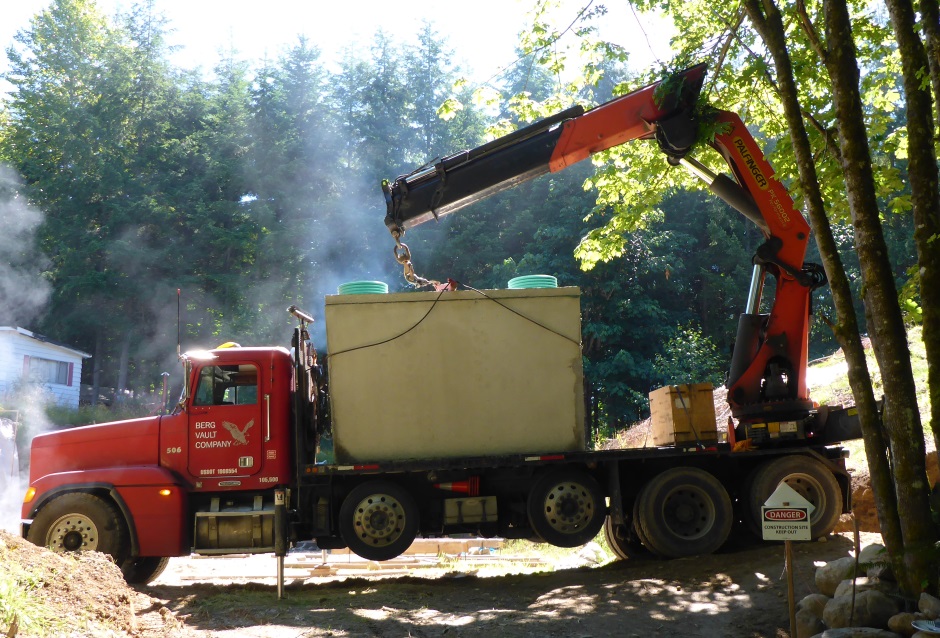
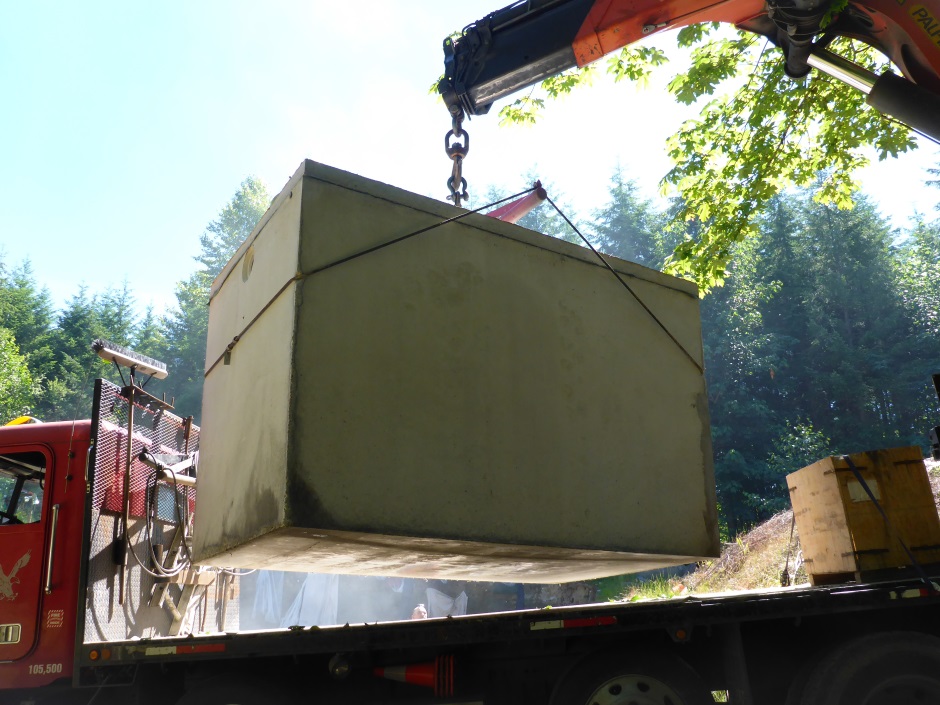
It is very important to get the dual compartment septic tank the right way round in the hole. The input end needs to be towards the house. The input end of a two compartment septic tank is the end with the biggest compartment.
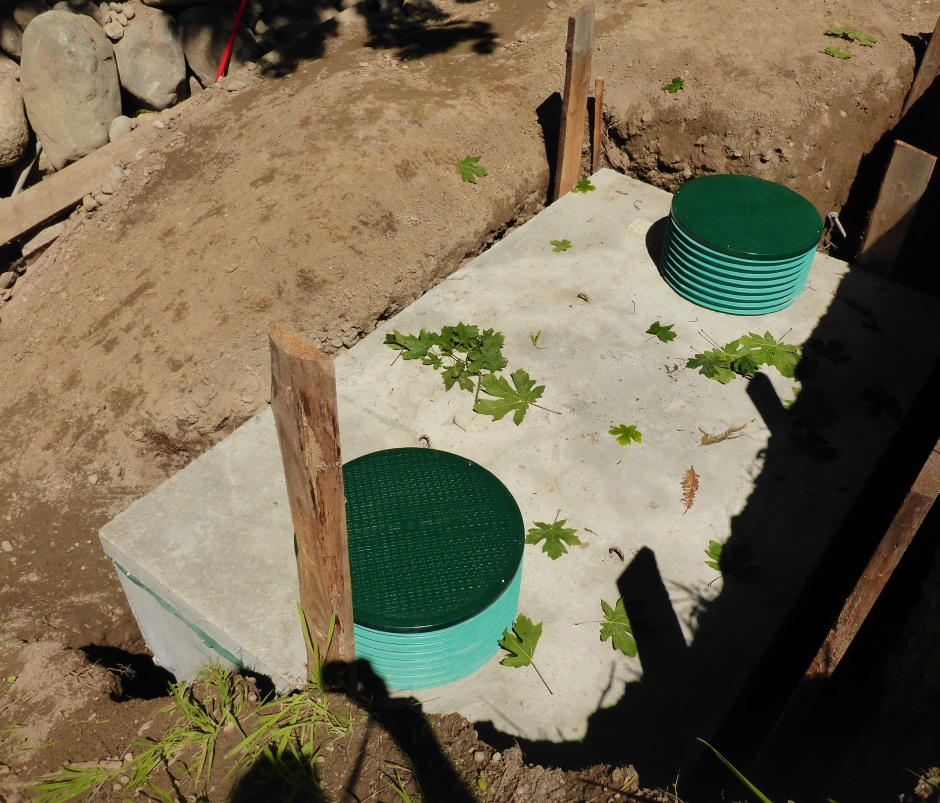
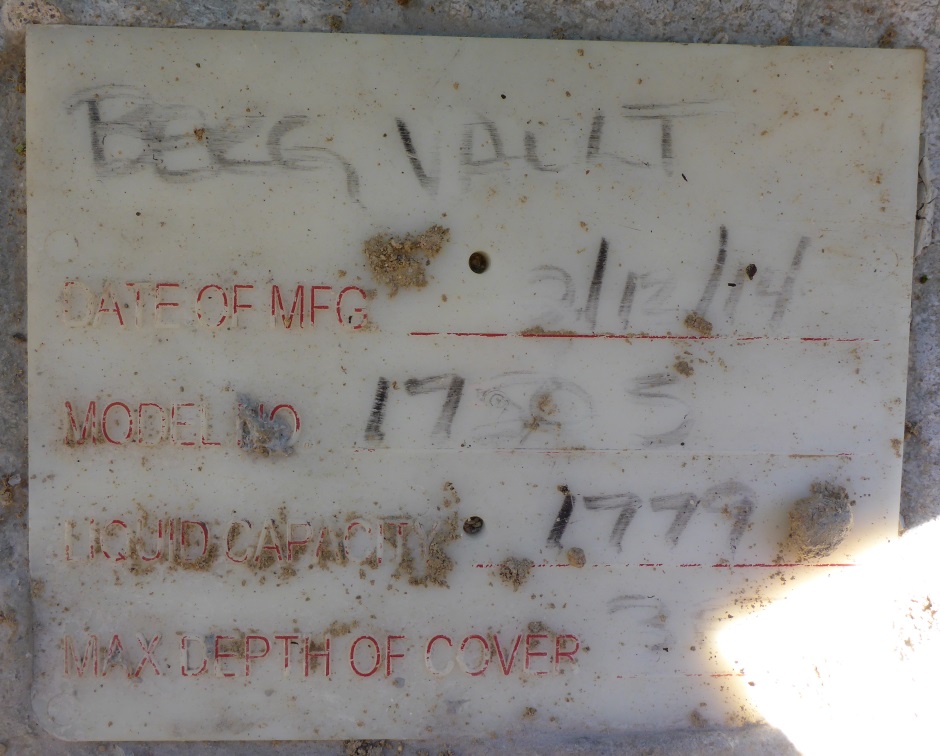
Pump Tank
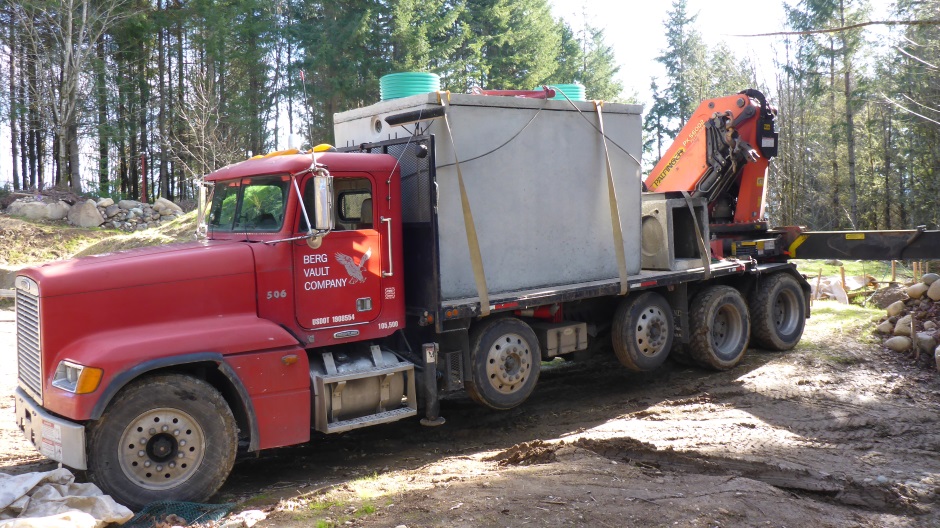
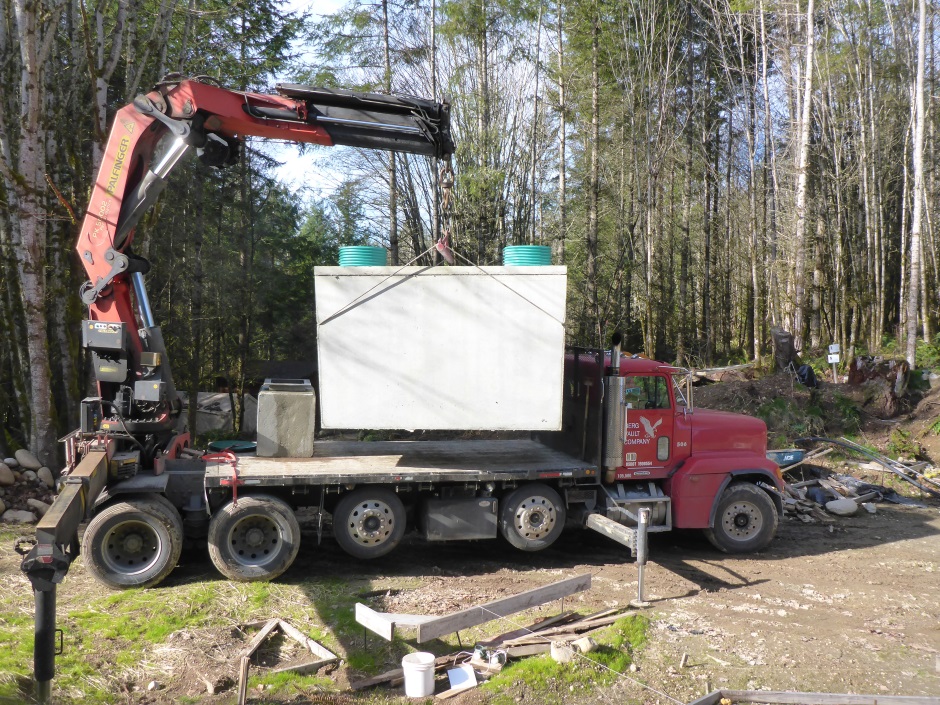
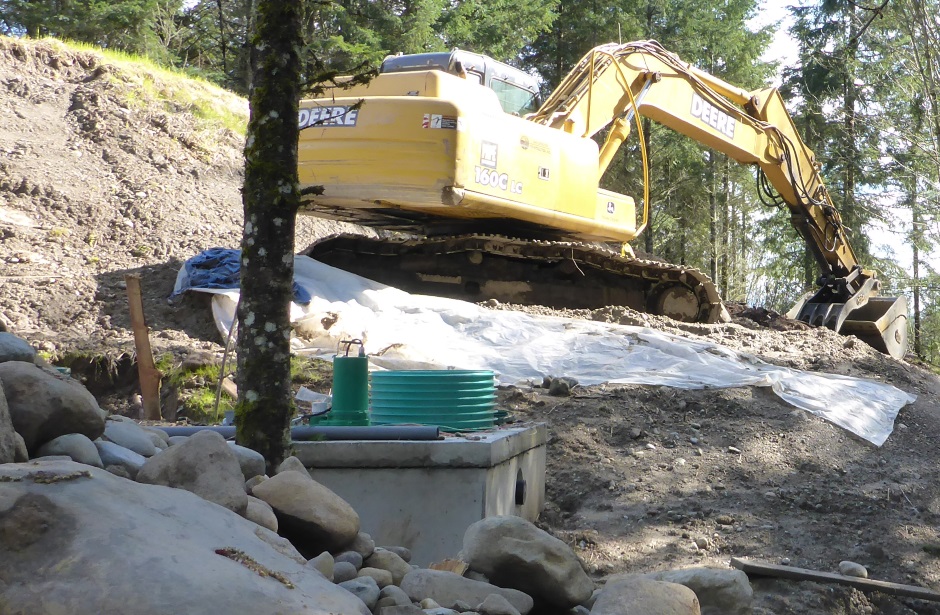
Filling-in over and around tanks
You should only fill around the tanks once the Licensed Septic Installer is happy that everything is ok and has approved the backfilling to be done.
It is best to filter the soil so you don't have any big rocks. Use a piece of galvanized wire mesh over a wooden frame.
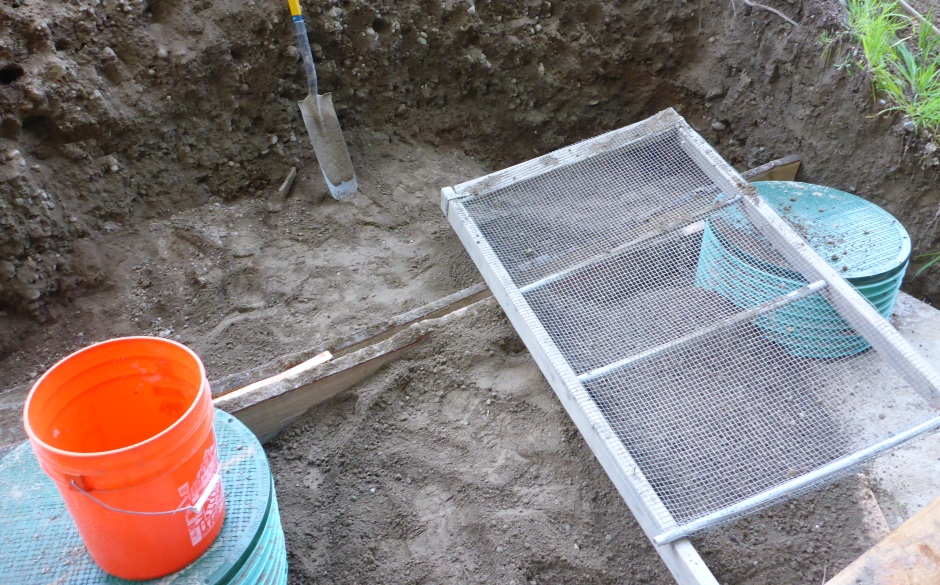
Pump between tanks
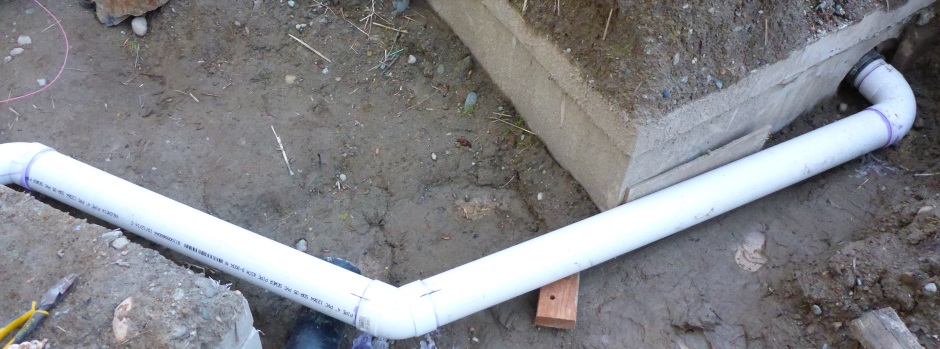
Support the pipe between tanks using a couple of bits of pressure
treated boards. Do not backfill until after the final signoff
inspection.
House DWV to Septic
From the house to the septic you need a 4" sched 40 sewer pipe. I use ABS pipe because it is strongest (although a little more expensive than PVC pipe). The slope all the way from the house needs to be a nice even 1/4" per foot. At the septic end the pipe pushes through the rubber gasket that is molded into the side of the tank on the input side.
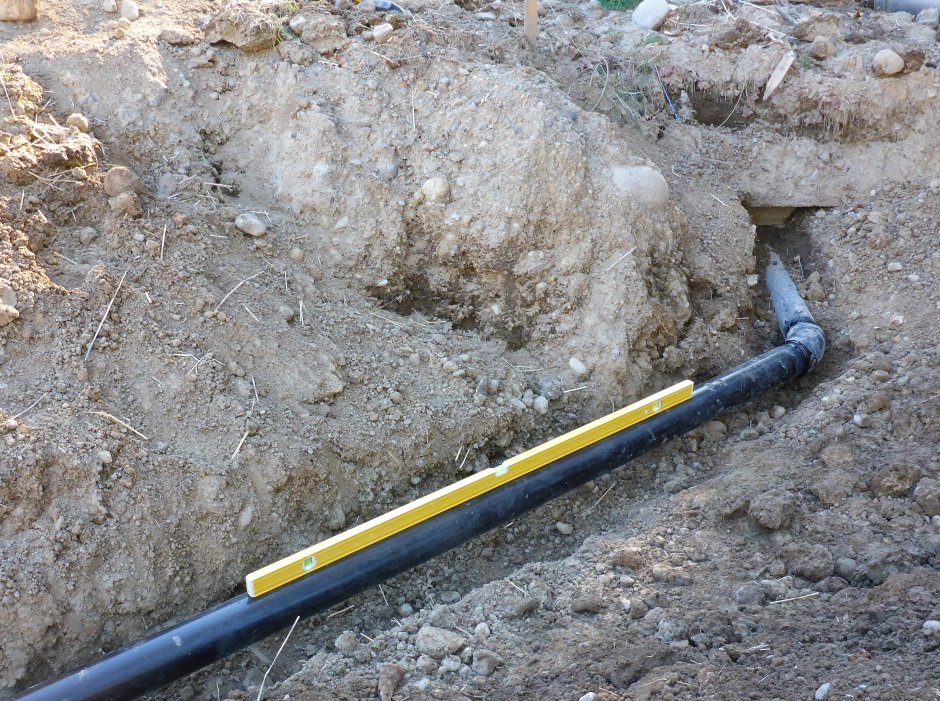
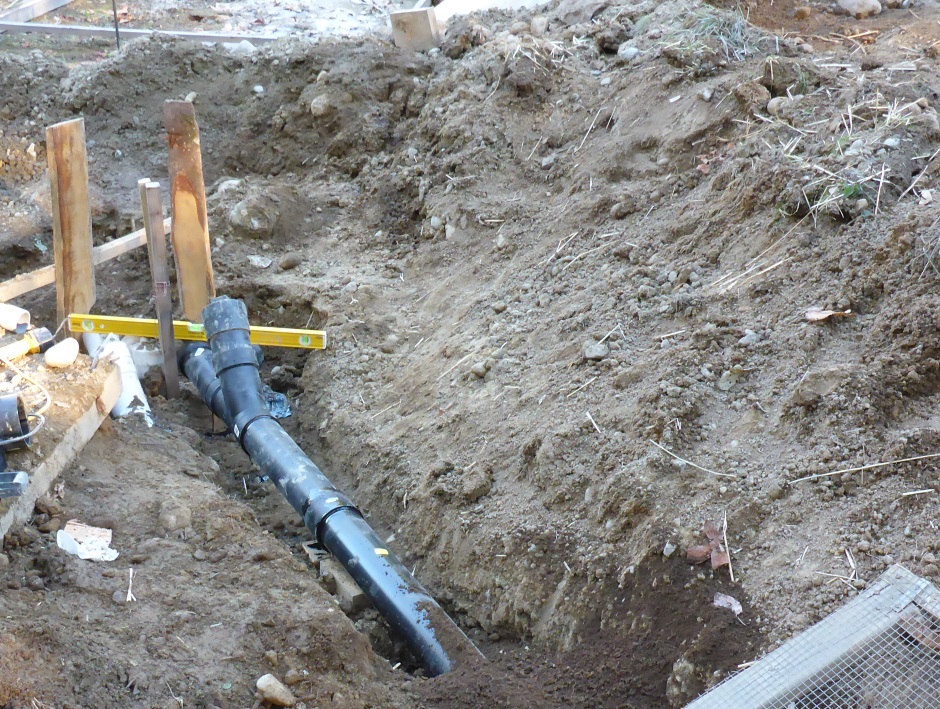
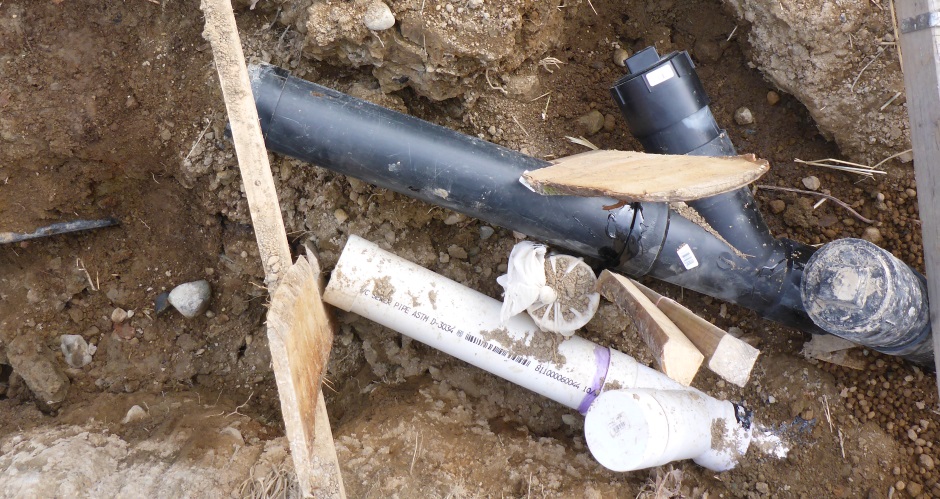
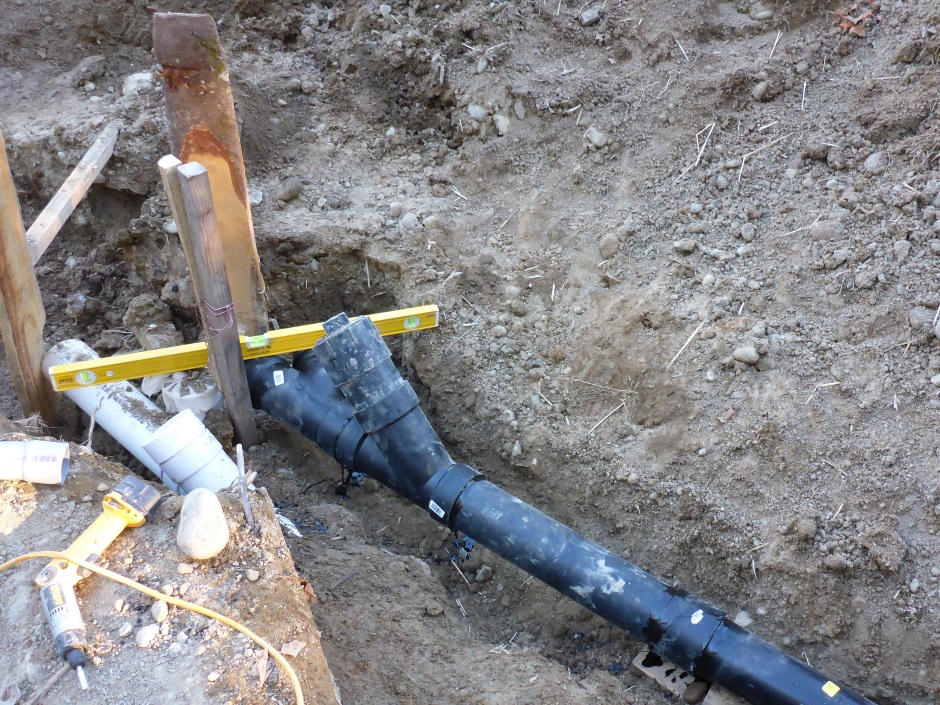
Finally you need to fill round the sewer pipe with filtered soil so there is no danger of a sharp big rock damaging the pipe.
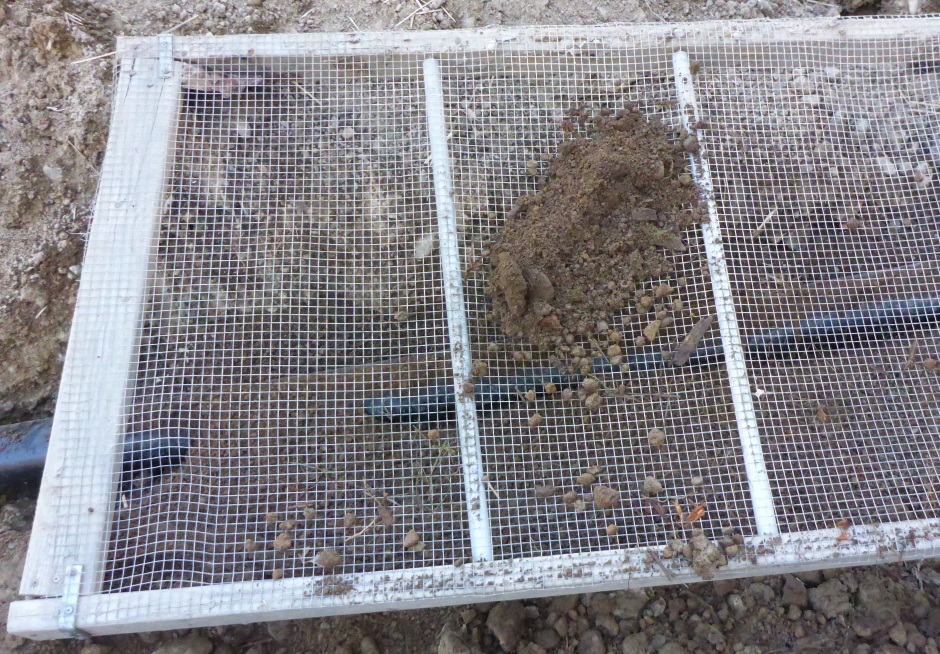
2" PVC pipe
This is the pipe that gets the high pressure effluent from the pump tank to the sand filter.
The septic system uses 4" ABS pipe whereas the pumped sewage uses 2" PVC pipe. The pumped (pressurized) sewage is carried by 2" PVC pipe in a ditch that is at least 18" deep.
Where the 2" sewer pipe comes near to or crosses over a water pipe then it needs to be sleeved by an additional 4" pipe. If the sewage were to ever leak from the 2" pipe then the sewage would be caught by the 4" PVC outer pipe.
At a water / sewage crossover point, the water pipe must cross at least 18" above the sewer pipe (and the sewer pipe must be sleeved). In my case I made the separation 22" to be safe. Above the water pipe needs to be an additional minimum of 12" of soil.
The health department requirement is for a fairly short length of outer sleeving pipe, but it my case I used 40 feet of sleeving.
When filling the pipe trenches it is important to use filtered soil, ie soil with the rocks removed.

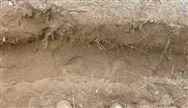
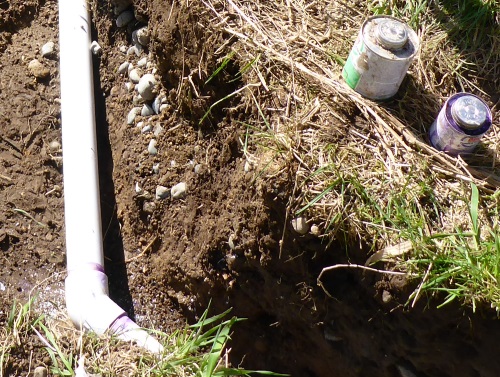
Don't backfill the 2" pipe all the way before the inspection. Leave example sections exposed. Do put soil under it to support it all the way along.
Provide a wooden box to keep the shutoff taps accessible even after the eventual full backfilling.
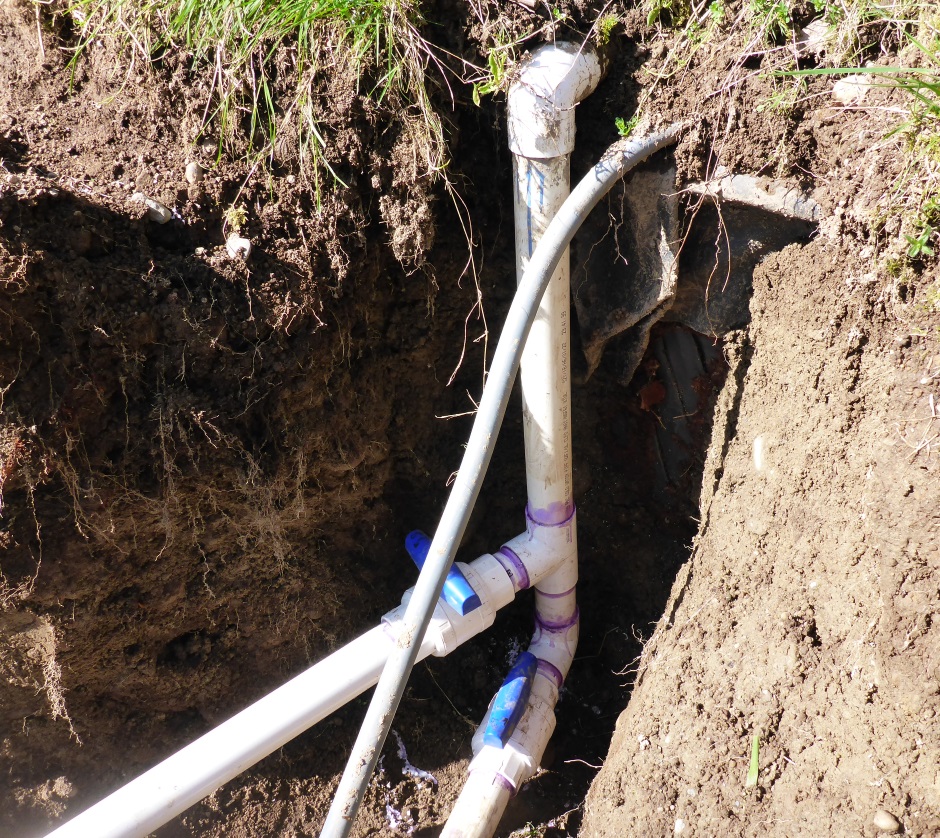
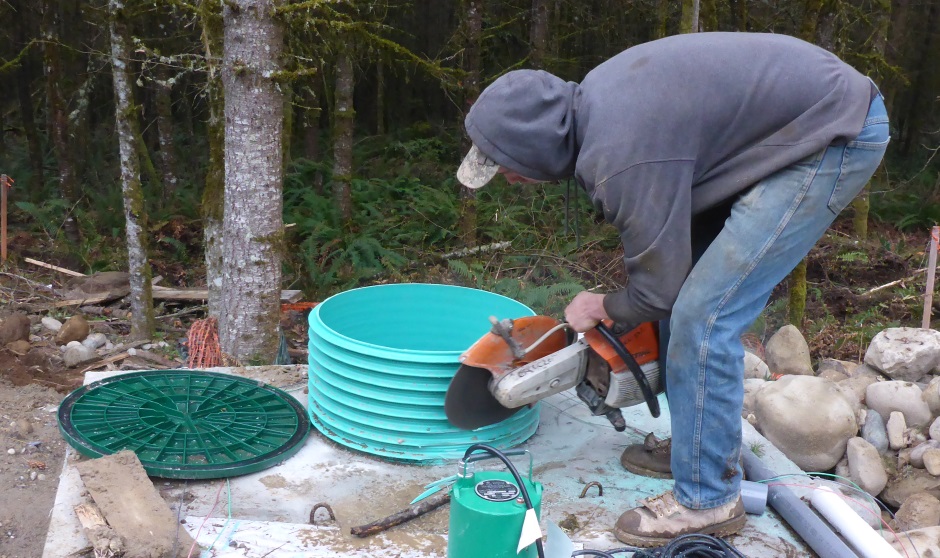
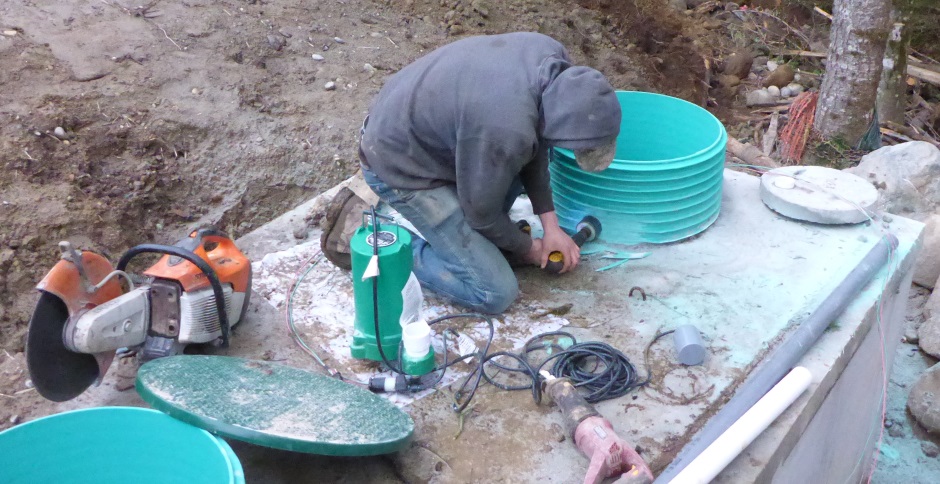
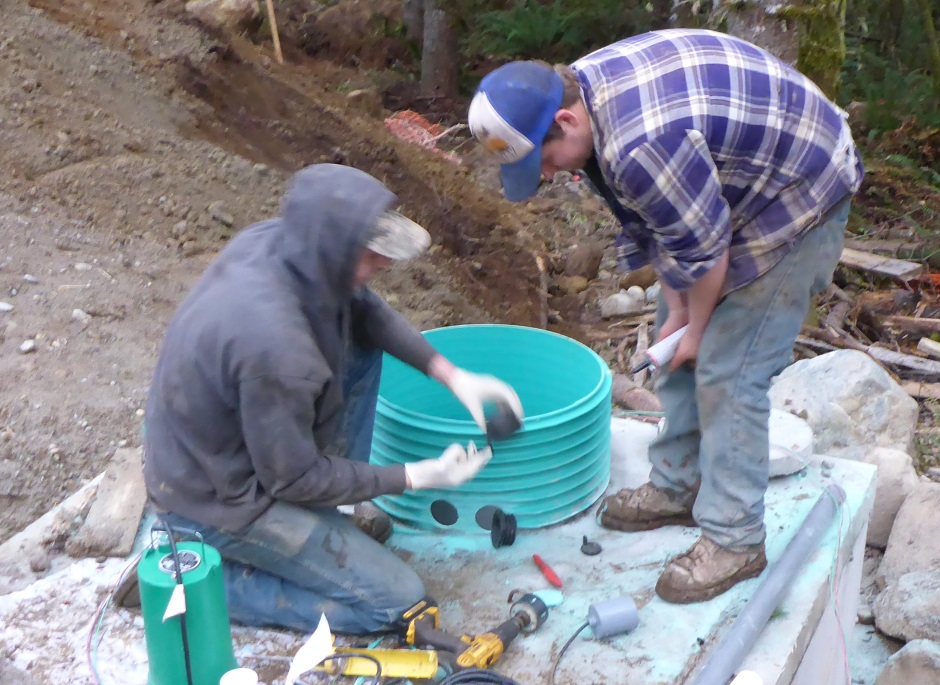
The check valve must be accessible, ie in the riser.
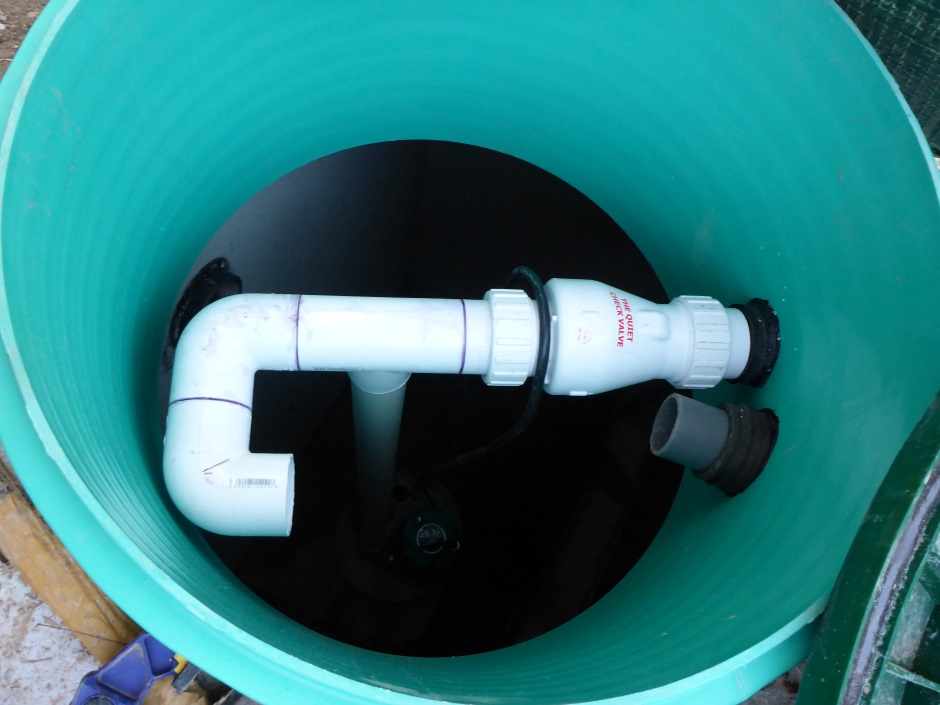
If the pump tank is lower than the drain field there is no point in adding a check valve to prevent siphoning as there is no risk of siphoning occurring. The official design from the licensed designer however shows an anti-siphon check valve so I have allowed space for it if the inspector insists. It would go the other side of the T piece after the 180 degree bend, but for the moment a sealed cap is used.
The pump stands on a concrete slab to raise it up from any sludge at the bottom of the pump tank. The provided round slab that has a plastic hole to hold the bottom of the float tree is only 2" thick so I also used some paving slabs to raise it to 3.5" as the design specifies a minimum of 3".
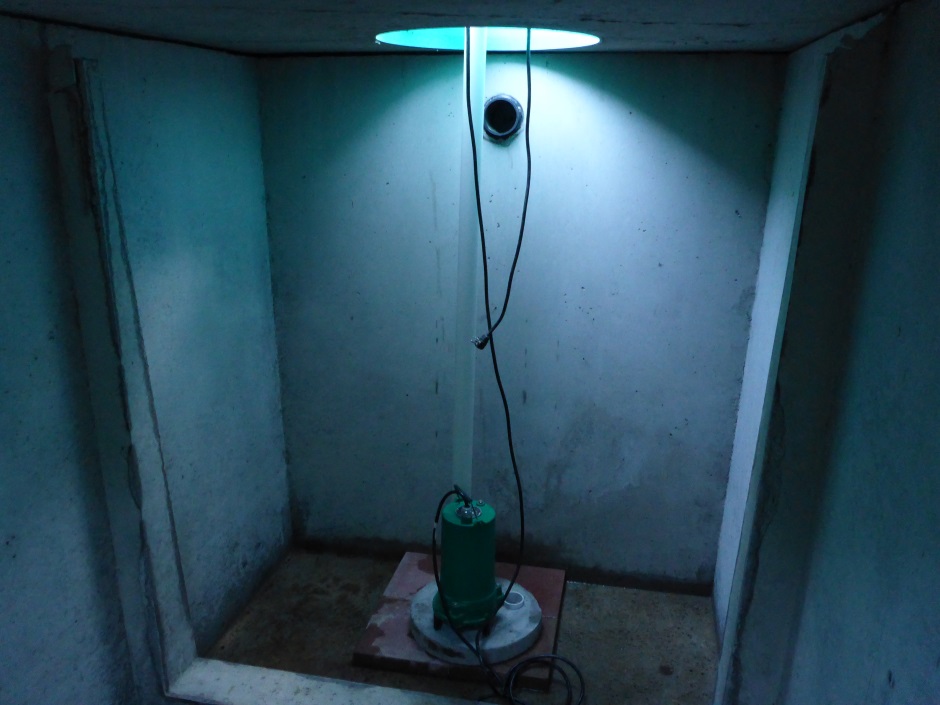
Provide enough cable length such that float tree can be lifted out.
Coil up the excess wire with a cable tie.
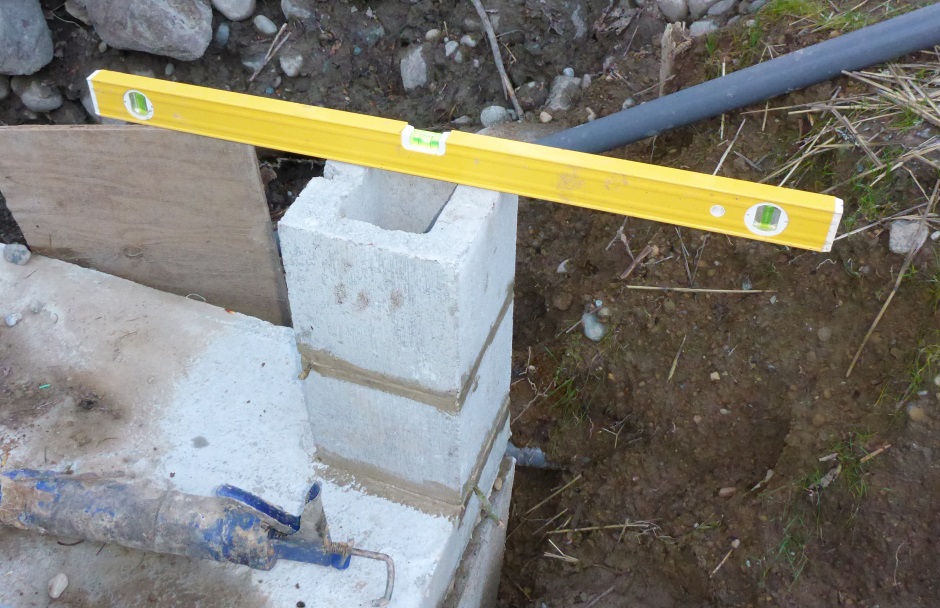
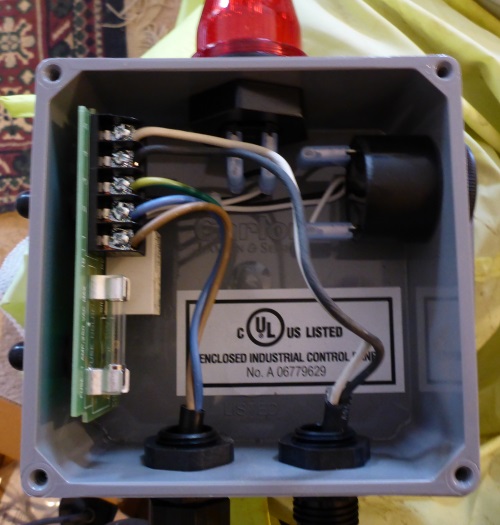
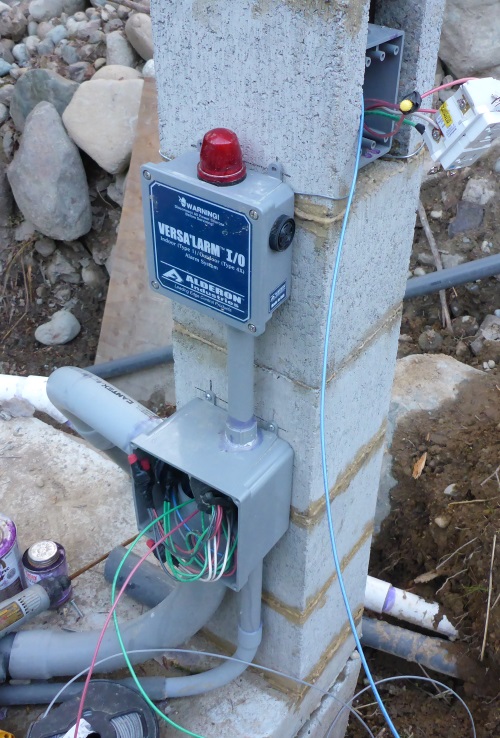
Preparing for startup
When the everything has been implemented, but before starting up the system, there are things you need to do.
Cleanout 2" PVC pipe
There will be plastic swarf in the pipe that must not be pumped into the sand filter or it will clog up the small holes in the sand filter pipes. With the pipe disconnected from the sand filter at the sand filter end, fill the pump tank with a couple of hundred gallons of clean water and pump it through the pipe to flush everything out.
Flush out sand filter pipes
One at a time, remove an end cap on one of the sand filter pipes, being careful not to pull them out of the ground. Turn the pump on for a few minutes. Crap (or at least crap sediment) will shoot out of the pipe so don't stand anywhere near. There will likely be 6 pipe caps.
Run clean water through sand filter
Connect the 2" PVC pipe to the sand filter. Make sure all the caps are on the sand filter pipes. Fill the pump tank with about 500 gallons of clean water and pump it through the sand filter and out to the drain field. This process helps revitalize the sand filter.
Things to note
Do not touch the valves on the sand filter as this will upset the balance.




